At least Jacqui and the kids were: I was talking to a car full of Tasmanians about what to see in Western Australia. I got quite a shock when the car in front of us drove out, but we were soon out into the rain and stopping for the fruit and veggie – quarantine - check where I handed over a few apples.
Heading West for Stanley we soon stopped to visit the Don River railway and museum, arriving about 15 minutes before the first trip of the day. The train was pulled by a newly restored engine that was built in 1906, reconditioned and redesigned in 1926 and finally brought back into service in December 1989 after 8 1/2 years of painstaking restoration. We all climbed into an old wooden carriage and got quite a shock when we flopped down on the leather covered, horse hair stuffed, seats as they were as hard as boards.
From the station we were pulled by the engine tender first, which was joined to the train immediately next to our compartment. The sounds, sights, and smells were fantastic and judging by the looks on the kids’ faces rivalled the voyage of the previous evening. The 3Km trip was down a slight grade and meandered next to the Don River for most of its length. Even light rain couldn't stop us from craning out of the generous windows to catch a view of the engine or the rest of the train as it became visible while wagging around corners.
The engine swapped ends for the return journey and we were back at the station approximately half an hour after leaving. The rain had really set in so we decided to press on.
At Burnie we had lunch in a shopping centre and bought some reading material and another umbrella. The library at Burnie was great, providing a place for the kids to play as well as giving us borrowing rights for us at any library in Tasmania! Jacqui was very happy!
We soldiered on through continuous rain, along good roads which in general hugged the coast giving us a good view of Bass Strait. It was so calm that you could almost be looking at Narrabeen Lagoon. The rain had carried brown coloured soil into the sea and there was a clear line between the green and blue sea water and that mixed with storm water.
The rain didn't ease for us as we set up camp in the Stanley caravan park at around 4:00 PM.
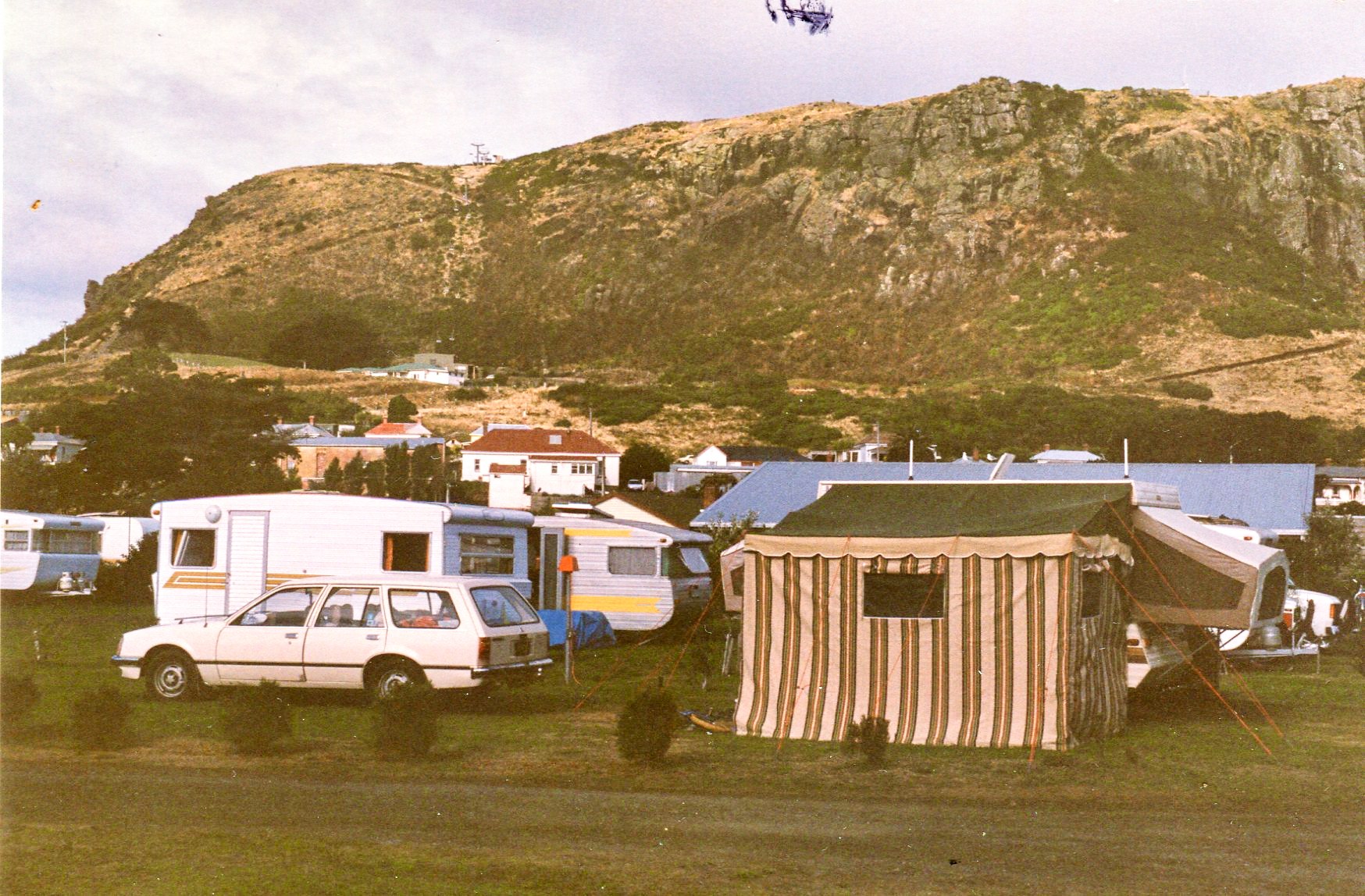
At the Stanley caravan park we put up the van annex to help shelter us from the rain that was falling when we arrived
The Nut, otherwise known as Circular Head, dominates the skyline with the town of Stanley snuggling around its base. After setting up camp we drove around the town admiring the many old buildings and the fact that a sheltered beach could be found in any wind.
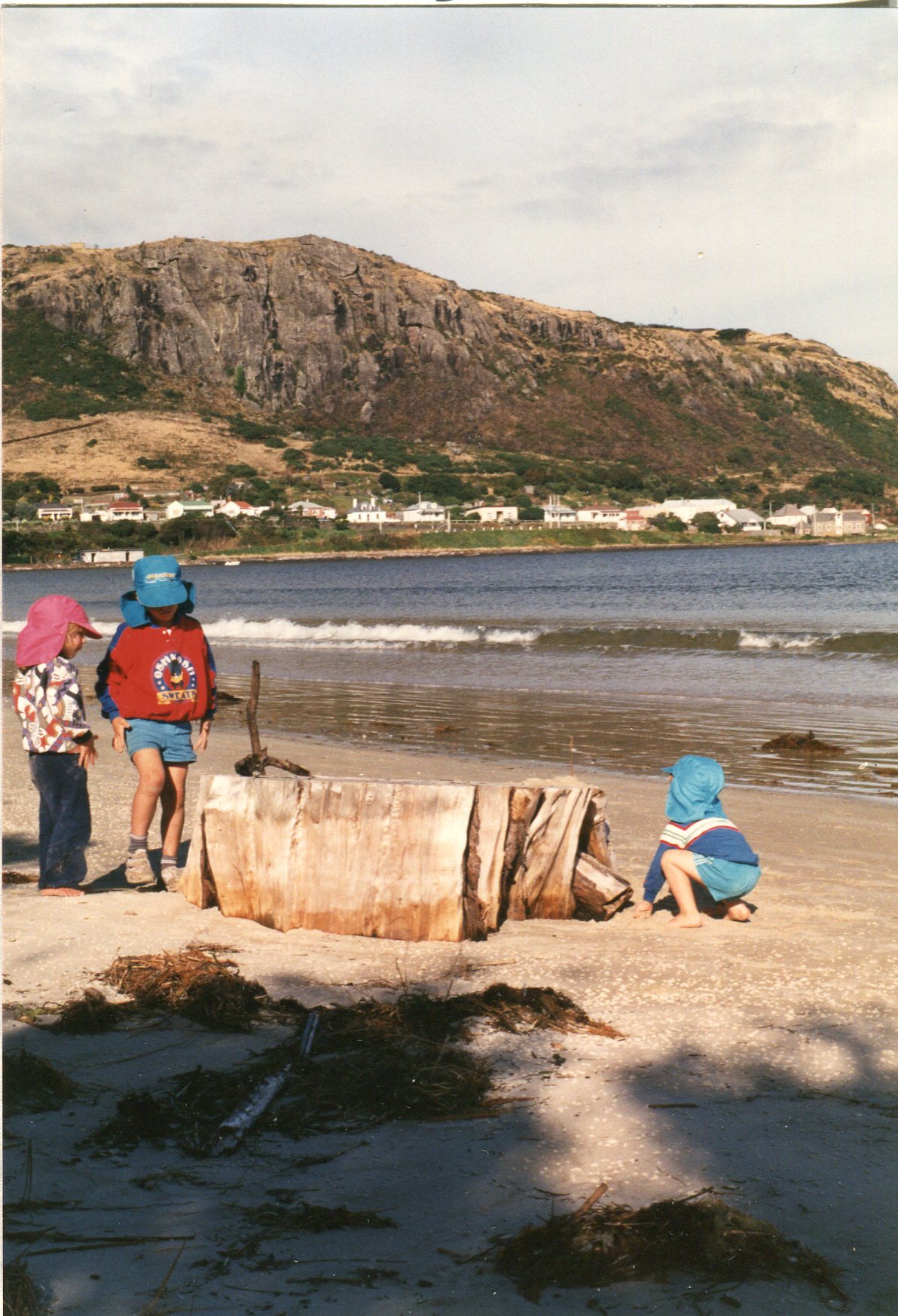
On the beach Stanley
Friday 2nd February 1990
We decided that today was the day Lachlan’s formal correspondance school lessons should begin, so it wasn't until after lunch that we planned to set off for a walk to the top of the Nut. The kids had a great time on the poor old rusting steam locomotive in the park next to the entrance to the caravan park.
The rain had held off all morning and it got positively hot just before lunch.
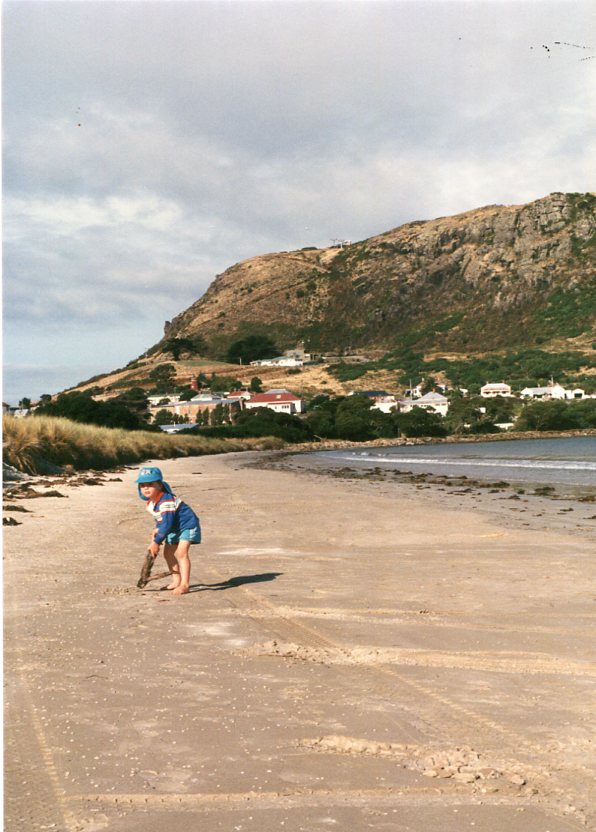
Rohan playing cricket on the beach next to Stanley Caravan Park
Having loaded everything and everyone into the car in preparation for a tour of Stanley and surrounding areas, it really started to rain, so we had to be contented with visits to the less exposed sites.
Everyone was impressed with the seafood shop. Two large rectangular concrete tanks held hundreds of live crays and as many fish of numerous species including leather jackets and blackfish. Live crayfish could be bought for $16.00/Kg and cooked fresh cray fetched $18.50.
Australia's Prime Minister from 1932 until 1939, Joe Lyons, was born in Stanley. We visited the reconstructed cottage where he lived as a child, now used as a museum. The display included photos and letters relating to Joe as well as everyday household items from around the turn of the century. Joy Lyon was born in 1879.
We also stopped in at an old inn which today holds a craft shop and museum. It was called the Plough Inn. Many of the items for sale were made from beautifully carved or worked local timber or nicely restored antiques. In both cases the prices were well beyond our budget.
Even the post office brought delight to us all in the form of two 1930s model manual telephone exchanges complete with recoiling chords and timing clocks.
On top of the nearby hill stands an old mansion called Highfields at present being restored by the National Parks and Wildlife of Tasmania. Despite the rain we ambled about the barns, stables, threshing sheds, and main residence.
All the buildings constructed from local basalt with cement render over it in some places. The mortar was made using sand from the beaches nearby as many shells are clearly visible. A well-preserved grave in the grounds of the house called our attention. It was the grave of Juliana Teresa Kerr who was aged 2yrs 10 months and 14 days. One of 15 children of the original owner.
With no end to the rain in sight we drove into Smithton for a look at this regional and fishing centre. Even now, only hours after being there, I can't recall anything except that McCain's process lots of veggies grown in the local area in Smithton. Jacqui does record in the diary that we bought King island Brie for $28.00 a kilo which is about the same price as in Sydney - we only bought $3 worth.
After a meal of curried crayfish pies, salad and champagne we invaded the local library which bravely opens its doors from 7:30 until 8:30 PM. We didn't stay long as the kids thought it resembled an adventure playground. We did however take out some interesting books on the local history as well as general reading material.
Saturday 3rd February 1990
First appearances can be deceptive: today began in much the same way as yesterday. Therefore, anticipating it would be dry in the morning and rain in the afternoon we set off, with wet weather gear, to walk up to the top of the Nut.
A one metre wide concrete path was split by a chain held up at 5 metre intervals by galvanised iron pipes embedded in the path. Walking up was relatively easy as we needed to go at a pace suitable for Rohan, who I must add coped very well. We were at the top in 10 to 15 minutes.
The plateau was gently undulating with tall grass, bracken, thistles, and thorn bushes making walking off the track difficult. From time to time we caught sight of sad looking sheep who knew where the tracks were and kept well away from them during the tourist season. They must use the tracks when people aren't around as there was a deeply rutted sheep track down the middle of most of the walking tracks.
As we walked around the perimeter of the Nut we were rewarded with stunning views of Stanley, it's harbour and the coast to the east and west. The activity in the harbour explained the constant toing and froing of semi-trailers as we saw a small roll on roll off ship called the Straitsman busily attended to by ant-like forklifts who deposited containers in her belly.
The wet weather didn't make it to the Nut, as it stalled about two to three kilometres away to the north where rain strung a translucent screen across the landscape.
Mutton birds or short tailed shearwaters had made several rockeries at various places around the edges of the cliffs. These areas were generally rabbit warren-like only the devastation seemed more complete. Jacqui notes that tiger snakes live in the rookery so mutton bird poachers should beware!
The trip down was much easier than it may have been as for $3.50 we rode down on the chairlift. Jacqui walked down carrying all our junk. She said the chain made the trip down much easier than it would have been without it. Her descent must have been relatively fast as she only arrived half an ice cream later than the rest of us.
The afternoon was taken up with general correspondence, Lachlan’s lessons, a walk along the high tide narrowed beach, and an unsuccessful attempt to lure some fish to their deaths using dad's patented bream bait [2020 note: I'm not sure what this was made of, a recipe that is now lost]. As the afternoon wore on it became apparent that the sun was probably going to shine. It did and by dinnertime it was warm enough to eat outside.
Sunday 4th February 1990
Weather-wise today was the most pleasant we have had since arriving here. After a morning of soaking up the sun we packed into the car with a packed lunch and packed ourselves off to a strangely named place called Dip Falls, 20 kilometres south of Stanley along well made, narrow, winding country roads. The trip was well worth the effort.
The first thing to impress us as we neared the falls was the incredibly dense nature of rainforest in Tasmania. That Stanley was serviced by ship for 20 years before a land route could be hacked out of the bush surprised us not in the least. What you could see from the road was closely spaced small trees with trunks about arm thickness arranged like bars, with tree ferns and taller stringy barks forming a dense canopy.
The walk down 152 uneven concrete steps took us through a fairy-tale world of muted greens with moss covering rocks and dead and living trees alike.
At the base of the steps we looked up at falls to see tannin stained water tumbling over vertical, regular hexagonal basalt columns, churning into white foam and spray. The broken tops of the basalt columns made the water fall its 50 or 60 metres in small steps before gathering itself into a fast-flowing creek about five metres wide that disappears into the dim light of the rainforest again.
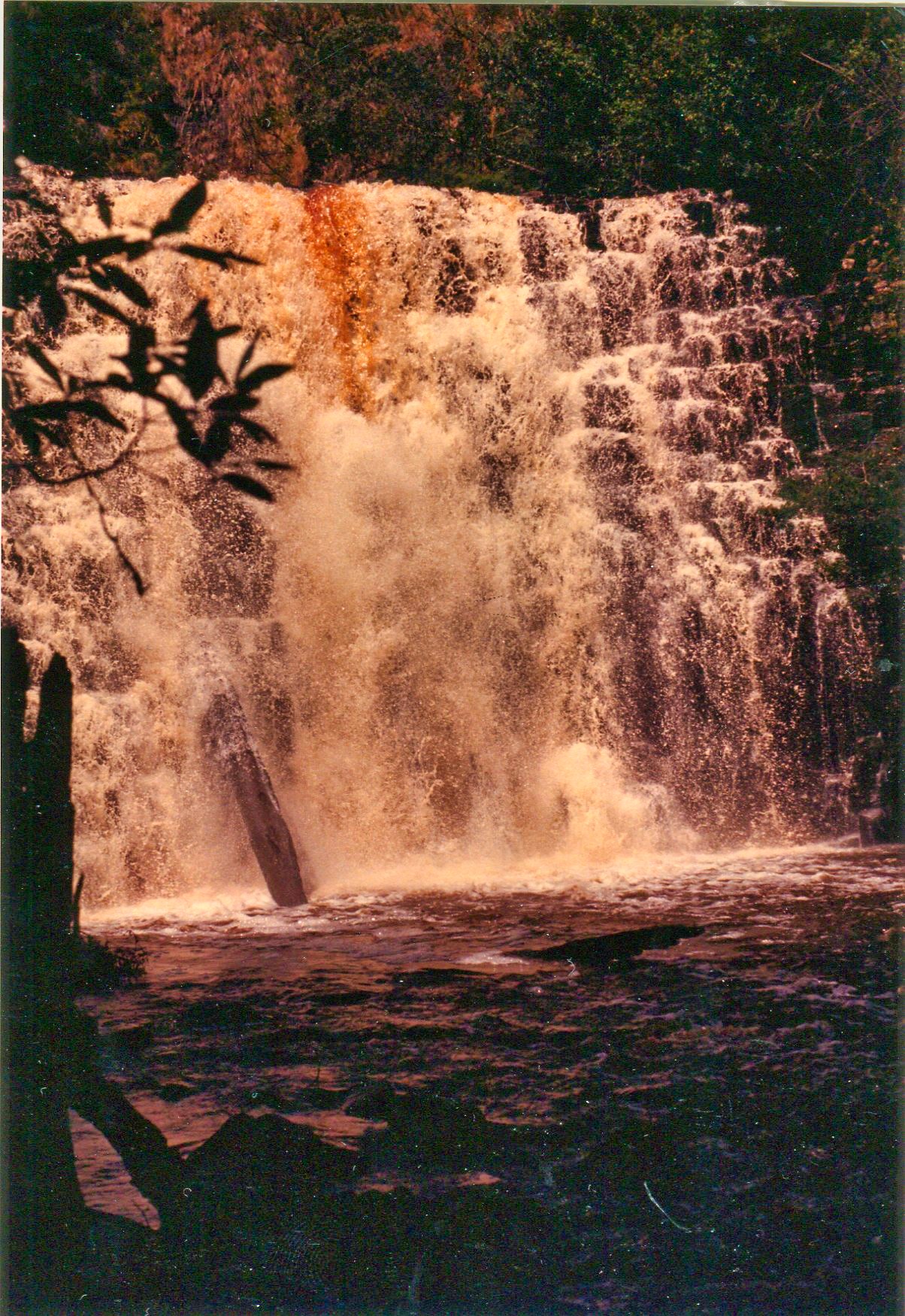
Dip Falls cascading over columnar jointed basalt
We picnicked in the shelter shed at the top of the falls, fighting off tenacious march flies as we munched our sandwiches. Having eaten more lunch than the march flies ate of us we crossed an old wooden bridge whose construction was strength from simplicity. In the centre of the Dip River there was a 4m length of tree trunk whose diameter was 3m at least. Its axis was parallel to the flow direction. Resting on the bank on both sides and the huge log in the centre of the river were two logs of about 1m in diameter but at least 20 metres in length. The wooden planks of the bridge were in turn supported by these impressive trunks.
The source of these huge logs became apparent as we ambled along a white dirt road for 1Km to the Big Tree. The kids complained about being made to walk so far but enjoyed themselves nonetheless stopping to peer intently at insects and rocks along the way. At each turn we would pass the decaying stumps of undeniably big trees that had toppled over after attack by homo sapiens’ chainsaws - a particularly venomous predator for big trees as well as their surviving relatives. The Big Tree in question was found spearing out of the lush green understory of tree ferns and birch-like trees into the sun, 60 metres above. About 4m in diameter and approximately 360 years old the Big Tree was worth the visit.
Back in the car we drove from almost 30km along narrow winding dirt roads to get back onto the A2 highway before turning off for Rocky Cape National Park. Tasmanians must be spoiled as they have a biased concept of what constitutes bad quality roads. The road to Rocky Cape was slightly potholed but in good condition compared to 90% of dirt roads in New South Wales. Still, some local had nailed up a small handwritten sign advising that the road was in very bad condition. Ha! I say - come to New South Wales!
Rocky Cape itself is a series of rounded peaks stepping out into Bass Strait. Each peak is covered by thick heath with the occasional, regularly spaced, clumps of stunted trees. These tree clumps give the whole place an almost artificial appearance.
Following the dirt track to the water's edge on the eastern side of the Cape I donned wet suit etc. and went in search of fish abalone and crays. Loading the speargun for the first time about 10 metres from shore the rubber broke. Foolishly I carried on out to sea, placing the rubber and its metal attachment under my weight belt. I swam out about 100 metres looking for crays and abs without success. In fact, I only saw one leather jacket worth spearing. Returning to shore I had lost the rubber with all its attachments. Not one of my best dives.
While the kids swam, Jacqui and I struck up a conversation with a tall bloke with big brown hands, laughing sided boots and a grubby John Deere hat. He was a local vegetable farmer who camps here with his family at the same time each year. He goes home each day to farm for McCain’s returning to his family in the afternoon. His slow talk belied a quick mind and our conversation ranged from the affect of a monopoly like McCain’s on vegetable prices to education, squid, surveying technology and seals eating fish from his net.
Back at Stanley we ate dinner, made our Sunday phone calls and were just about to return to camp when we heard there was to be a penguin tour leaving in a few minutes for $0.50. Jacqui raced back for shoes etc. and we were off to the boat harbour with a group of about 20 people. Our guide was armed with a red dolphin torch and a powerful 12 Volt spotlight which was connected to a motorcycle battery slung over one shoulder.
As we walked along, he (I didn’t catch our guide’s name) told us of the history of Stanley by referring to the bay, whale strandings and houses. Arriving at the port area we were stopped as a group of about 6 juvenile penguins waddled past on the way to their nests amongst the mess of cyclone fences, logs and buildings. Proceeding to the break-wall we observed several more penguins which were nesting on jumbles of junk and rocks as well as others trying to bodysurf onto the rocks. The small but powerful waves together with the blinding light from our guide’s spotlight conspired to ensure no further penguins reached shore - at least while we were watching.
Pointing his light skyward we saw mutton birds soaring around the tops of the cliffs as they prepared to land in the rockeries nearby. Heading back, we were given a talk about the fishing fleet, bag limits, licence cost and ship costs. All expensive!
Monday 5th January 1990
A trip around through Mawbanna and Arthur River was the programme for this day.
We left a little before lunch and headed west to Smithton where we filled up with fuel and went to the supermarket for groceries. At the Roelf Vos supermarket [2020 note – this was a very popular Tasmania only supermarket until sometime in the 2010s it was subsumed by Woolworths] we bought amongst other things 2Kg of apples at $1.99/Kg or $1.99 for 2Kgs (yes - confusing I know) and the number 14 chicken for $5.05. Since they use laser barcode scanning [2020 note – this was new and somewhat controversial technology then], we were through the checkout quickly. Jacqui checked the receipt and found that we had been over charged for the chicken: $5.13 and the apples: $2.99. As is the policy in such supermarkets when an item scans at a higher price, we were refunded the entire cost of both items.
After travelling through undulating dairy country and out from under the cloud cover, we turned left at Mawbanna heading south about 2 kilometres inland from the western coast of Tasmania. I had always imagined the west coast to be rugged with steep gorges coming right up to the sea. The reality is an undulating plane covered with low heath or mallee like scrub.
At a lighthouse called Bluff Hill light, we turned off the road and followed another to the coast and a group of huts or houses - home for holiday makers and abalone divers.
We had lunch on a stony little beach in Lausen's bay that was covered with kelp amongst jagged dinosaur-like rocks. The beach was sheltered from the open sea, calm and possibly a good place to dive. Unfortunately, I'll never know if it was as I had left my diving gear at camp.
Returning to the main road, we headed south for Arthur River in time to see the river cruise return at about 3:00 PM. Arthur River itself is different: all the streets are dirt and most of the houses a little more than fibro shacks. The River, about 50m, wide is the colour of tea-like [English breakfast I think] water.
South of Arthur River the road improved significantly, widening out to a newly made dirt highway. We soon discovered the reason as we drove from low scrub into a magnificent forest similar to that that we had seen at Dip Falls. It was a State Forest and the road was used for logging trucks.
Logging was by the clear-fell method devastating the whole of one coop. Not a pretty sight!
Jacqui gives then premier of Tasmania Robin Gray a (well earned) serve.
Our trip back to camp was via narrow backroads that service the many dairy and vegetable farms in the area south of Stanley.
Tuesday 6th February 1990
We had originally intended to move on today, but Rohan is unwell so another quiet day was called for. The most active thing we did was to walk to the Harbour with Anja and Rohan to watch Lachlan fish with 20 others from the wharf. Most fishers were catching good size fish - around about 30 centimetres and longer - and many had at least 20 in their baskets. Lachlan nearly caught several, but they dropped off on the way up.
Wednesday 7th February 1990
Despite the weather forecasters, who had predicted a fine mild day, this day dawned overcast with a chill northley gale. This made packing up unpleasant, doubly so as Rohan wasn't feeling 100% and tended to be clingy.
But pack up we did hitting the road at 11:00 AM for Burnie and then Cradle Mountain National Park. At Burnie we shopped. I tried to get a new rubber for my speargun without success, but I did buy a pair of flash looking booties. Just before leaving town we filled up at 69.9CPL only to find fuel at 65.5CPL about 10 kilometres south.
The trip to Cradle Mountain National Park took 2-3 hours and carried us through the most varied countryside, from neat dairy farms to rainforest in rugged mountain gorges, pine and eucalypt plantations and eventually the grasses and heath of country above the snow line.
The camping area is new with beautiful shingle-roofed amenities and wallaby's hopping all over the place. Something white and fibrous was sprayed over the shingles of the amenities and we were puzzled as to what it was. Anja delighted us all by insisting that they weren't wallabies but we're wobbilies. There was even a cheeky currawong who scavenged bread from a box of supplies left unattended as we set up camp.
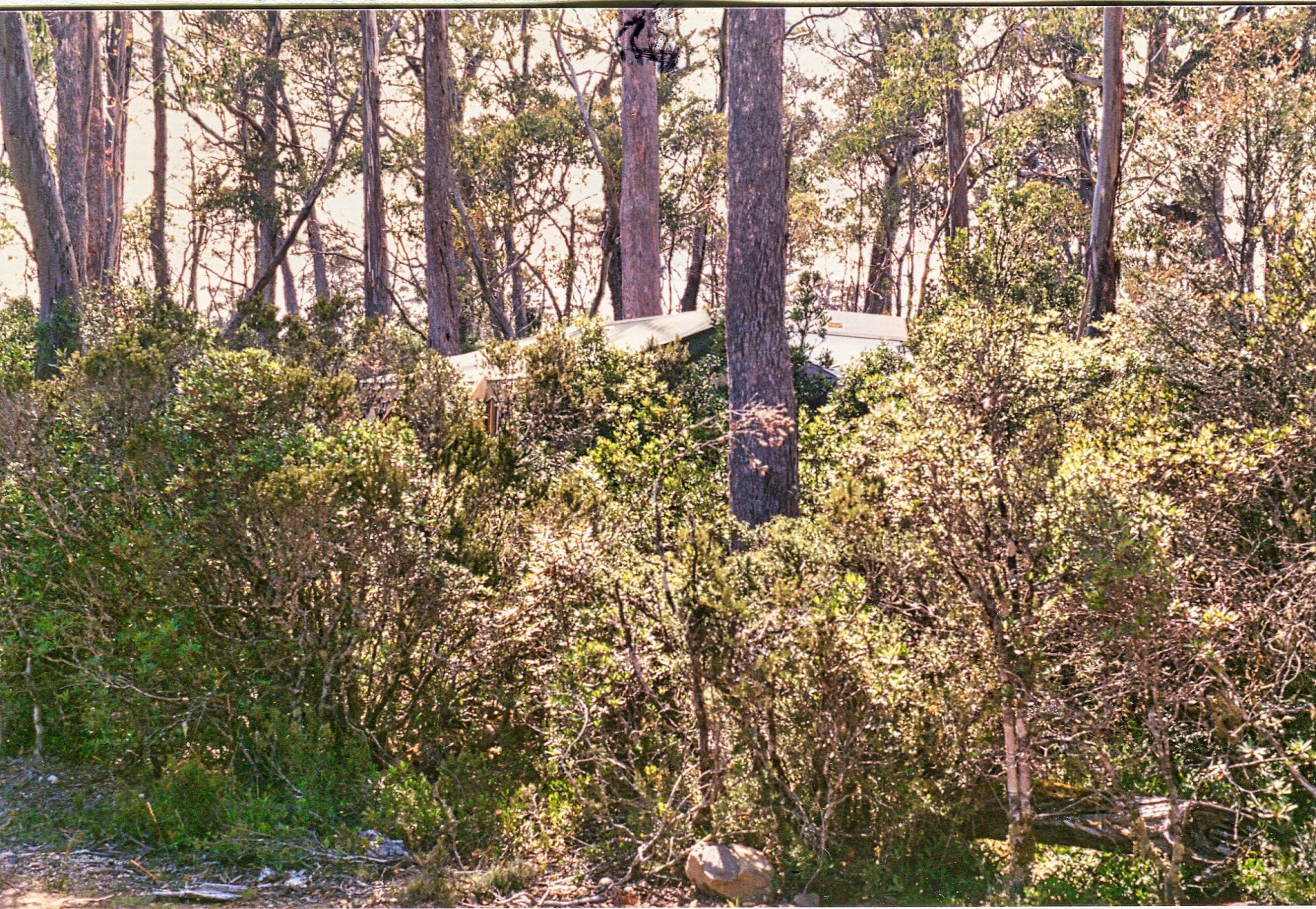
Camping spots at the Cradle Mountain were screened by vegetation from neighbours providing privacy and wildlife corridors for pesky possums
Everyone, except Jacqui, seems to be suffering from a cold to various degrees. I hope we are up to some walking tomorrow.
Thursday 8th February 1990
We had a disrupted night's sleep because Rohan couldn’t remain peaceful for more than 1 hour. He'd wake up, or at least half wake up, and scream “I want a drink of water” or more accurately “Iwannadrinkofwater” which to me meant nothing. It took Jacqui’s bilingual abilities to interpret. Further enhancing our peace, he spent a good deal of the night in our bed.
It was 9:30 AM before breakfast was served and we spent the morning relaxing. I shouldn't let Jacqui hear that for she did a good-sized load of washing by hand before lunch.
For lunch we had salmon, asparagus, cheese and tomato sandwiches. After packing up we drove to the rangers’ station and onto Dove Lake.
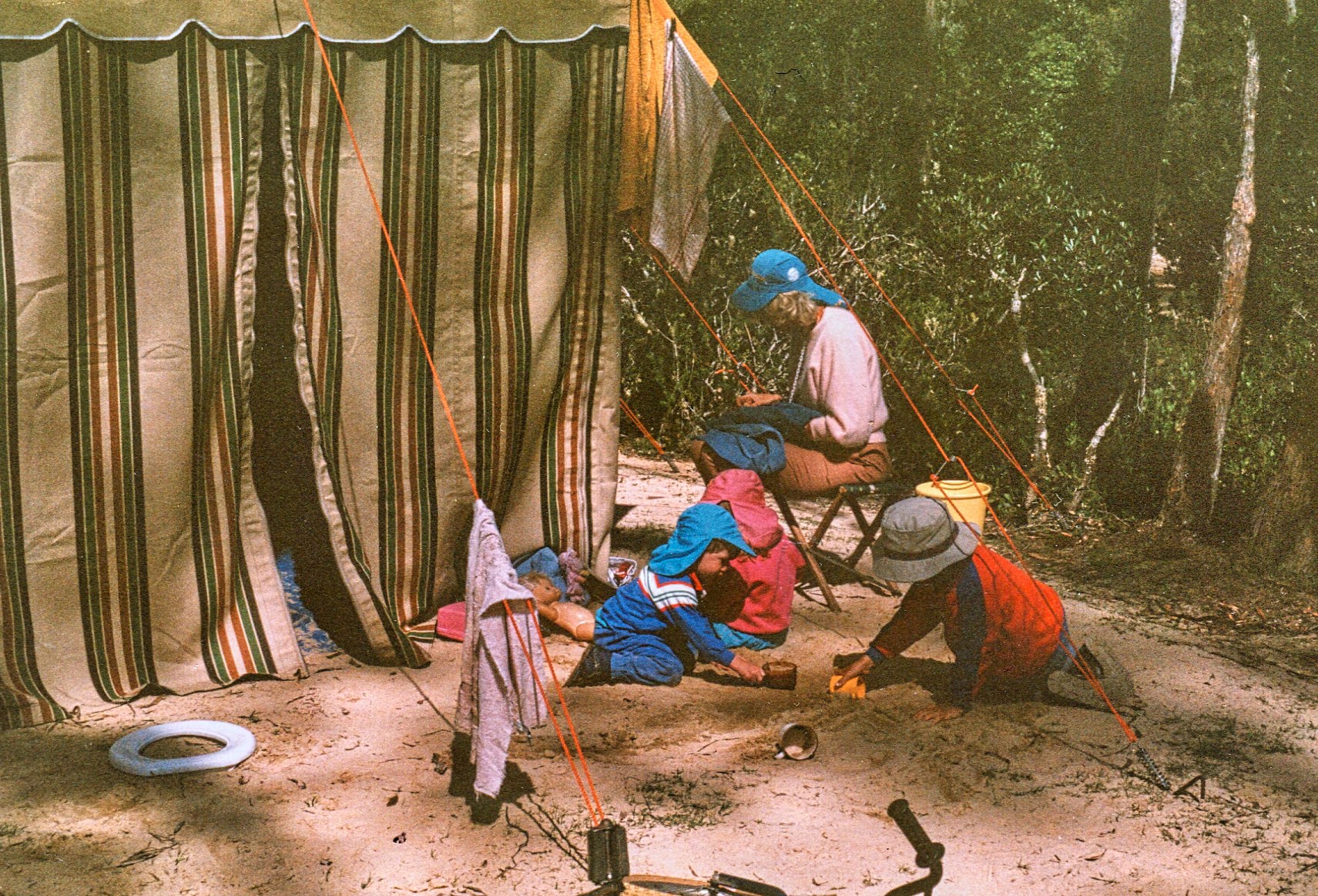
The kids loved the soft sand around our Cradle Moutnain camp site which was good for making roads and castles
The Rangers’ station had some excellent displays and a unique activity centre for kids. Raised shapes of hands, palm trees, diamonds and circles could be copied by placing a sheet of paper over the top and rubbing with a crayon. Additionally, photographic displays highlighted the natural beauty of the park and the inherent difficulties of keeping it in good condition with thousands of visitors each year.
About 6Km further up a narrow, rough, dirt road, with views of Cradle Mountain and other high peaks appearing and disappearing, we pulled up in a car park at Dove Lake.
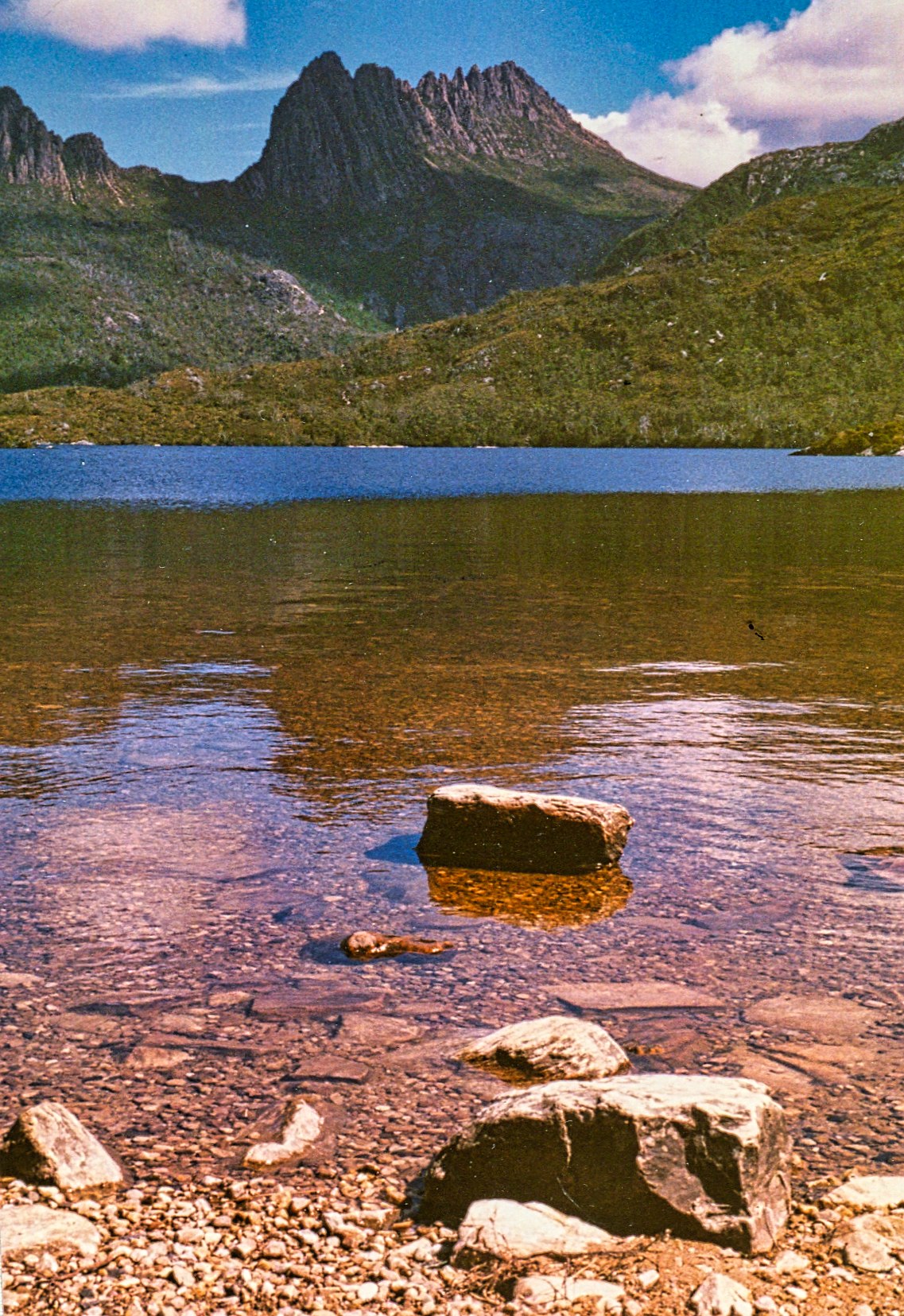
Dove Lake and Cradle Mountain
The view was well worth the trip, Cradle Mountain rising defiantly above the lake which meandered off into the glacier gouged valley. Various walking trail set off in all directions and a sign described the vagaries of the mountain weather. We were fortunate to be here on one of the 32 sunny days as there are 297 cloudy days, 266 wet days and 50 snowy days each year on average.
As we lazed around the car we watched as people returning from walks. Some obviously hadn't taken appropriate precautions against the high intensity ultraviolet radiation and were lobster red. We spoke to a family of four, with two young girls of 8 and 10 years, who had been on a three-day trek and were nursing sore feet by walking in Dove Lake. The low temperature water having the desired pain numbing effect. Anja tried it too, but with shoes and socks on! She was not impressed and cried loudly until her wet articles of clothing were removed.
Driving out of the car park we passed a young couple seeking a lift. Jacqui crowded into the back seat with the kids and the couple sat stacked in the front seat. They had been on a day walk and said the hardest part was a very steep downhill section close to the car park.
There are lots of tame animals here to delight the kids. Hopping around are pademelons or small wallabies. At night we are visited by the local brushtail possums. Last night, before Jacqui and I went to bed, one forced its way into the annex by squeezing between the ground and the canvas. It started to check out the garbage. In response we put all edible material into the van. This morning I had to redefine my understanding of what edible means to possums as one had removed a pair of my dirty underpants and chewed a hole in them. Tonight, after a story the kids were preparing for sleep and Jacqui was in the shower, I heard a scrabbling in the annex. Investigating I found a big black possum chewing on a slice of bread it had found. In an attempt to encourage it to leave I managed to shoo it into the caravan, much to the delight of Lachlan and Rohan who were still awake. Anja, fortunately, was asleep and she didn’t stir as the possum escaped by walking over her.
Friday 9th February 1990
With Rohan still unwell we decided that today I would take Lachlan and go for a walk. The weather forecast was good with some light overcast in the morning. We still went by the book though and packed 2 day packs with clothes for a blizzard and food for a week.
Jacqui drive Lachlan and I to Waldheim where we were visited by 4 potoroos who were obviously expecting food as they almost crawled into the car, much to the delight of Anja and Rohan.
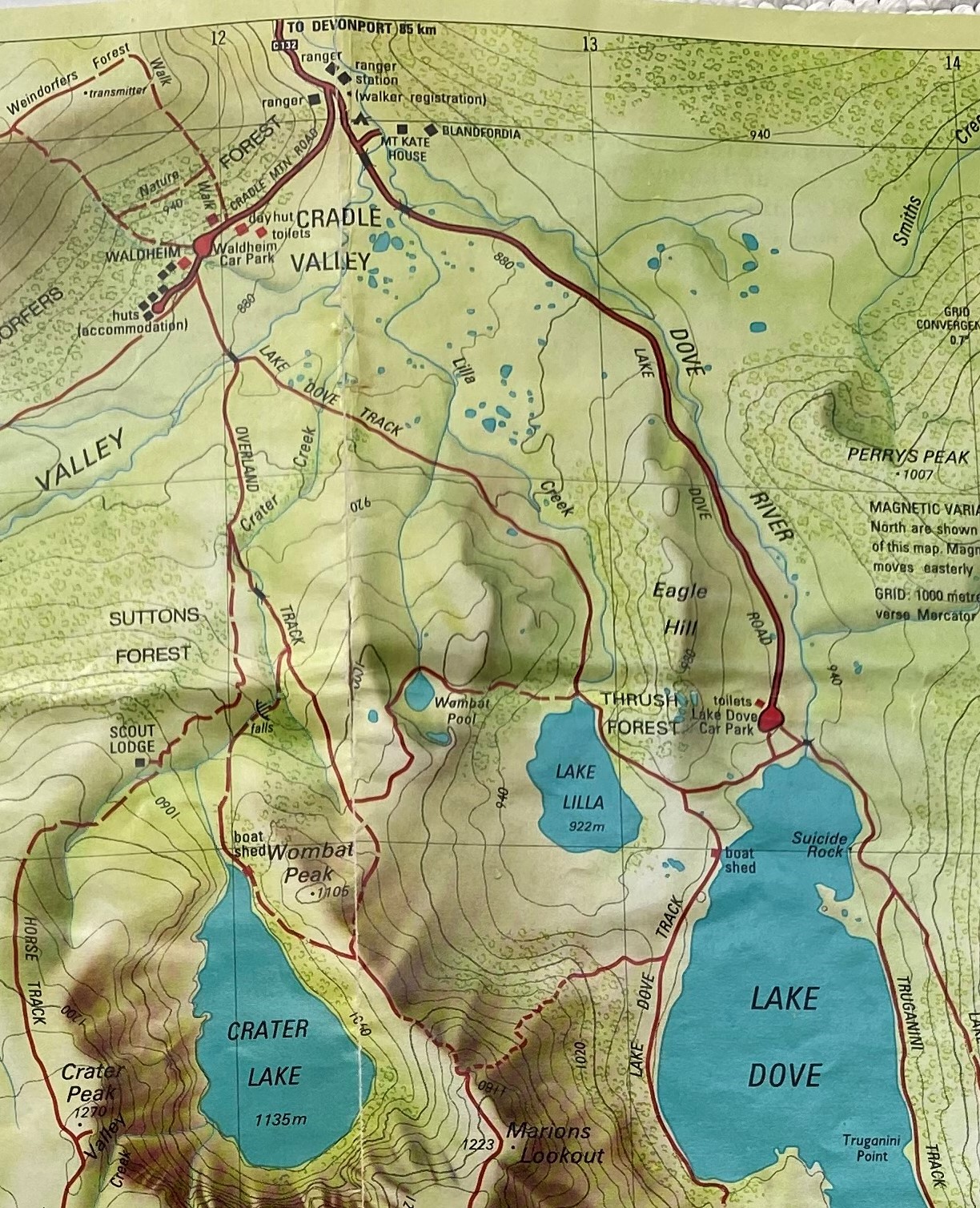
Lachlan really look the part with long sleeved shirt, army canvas hat, sunglasses, shorts, blue socks and running shoes all topped off with a day pack. We headed along built timber tracks for Crater Falls, Lachlan asking questions about everything he could see. From these 3-4 metre high rainforest covered falls we continued upwards to Crater Lake. This is a beautiful tear-drop shaped lake with small stream pouring out of the narrow end. The stream flows under old weather-beaten logs which were great to sit on to watch other hikers throw bread to the trout fingerlings.
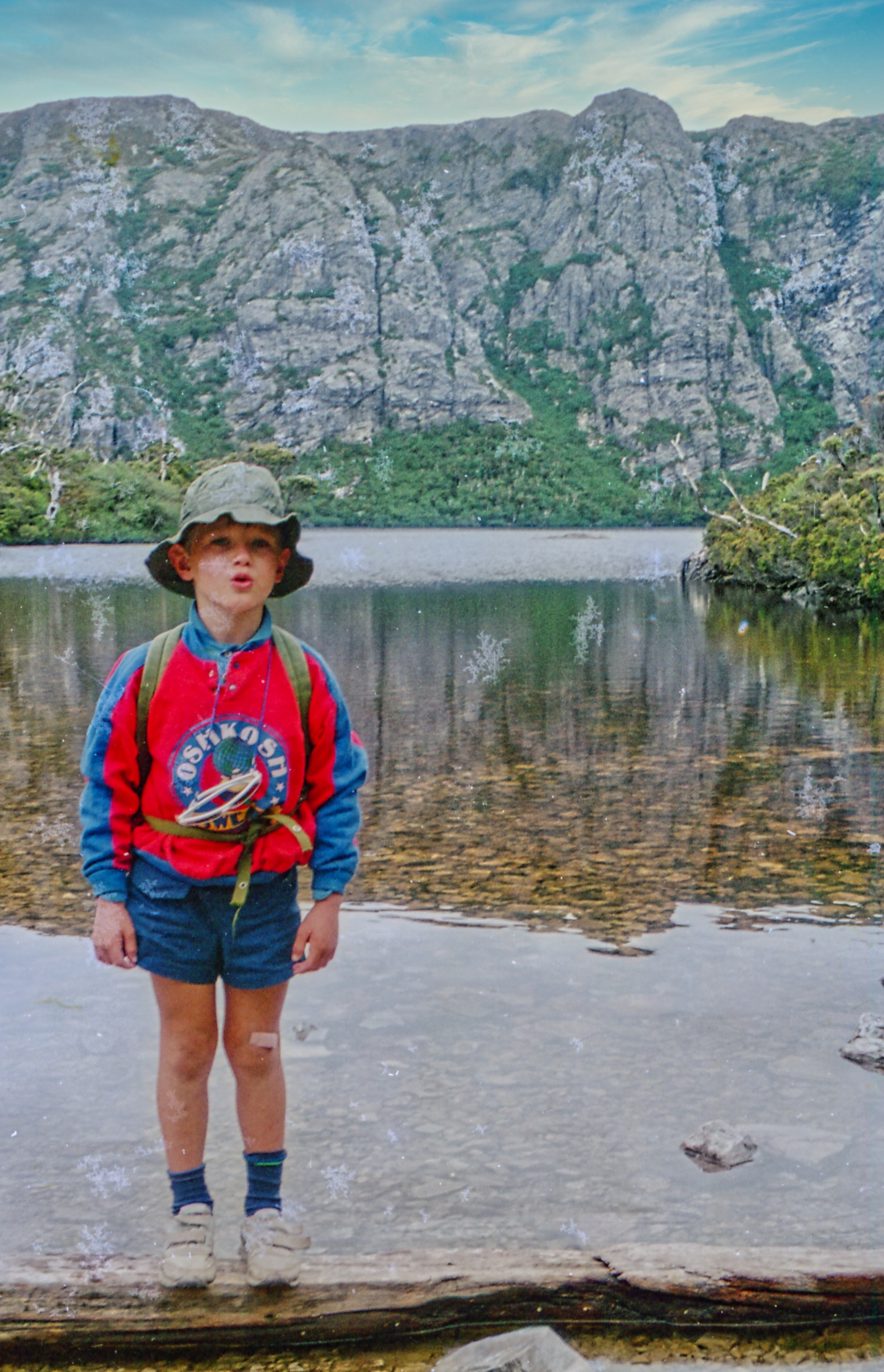
Now the steeper sections began, narrow with rainforest vegetation crowding in at first but this soon gave way to the low heath which characterises vegetation above the snow line.
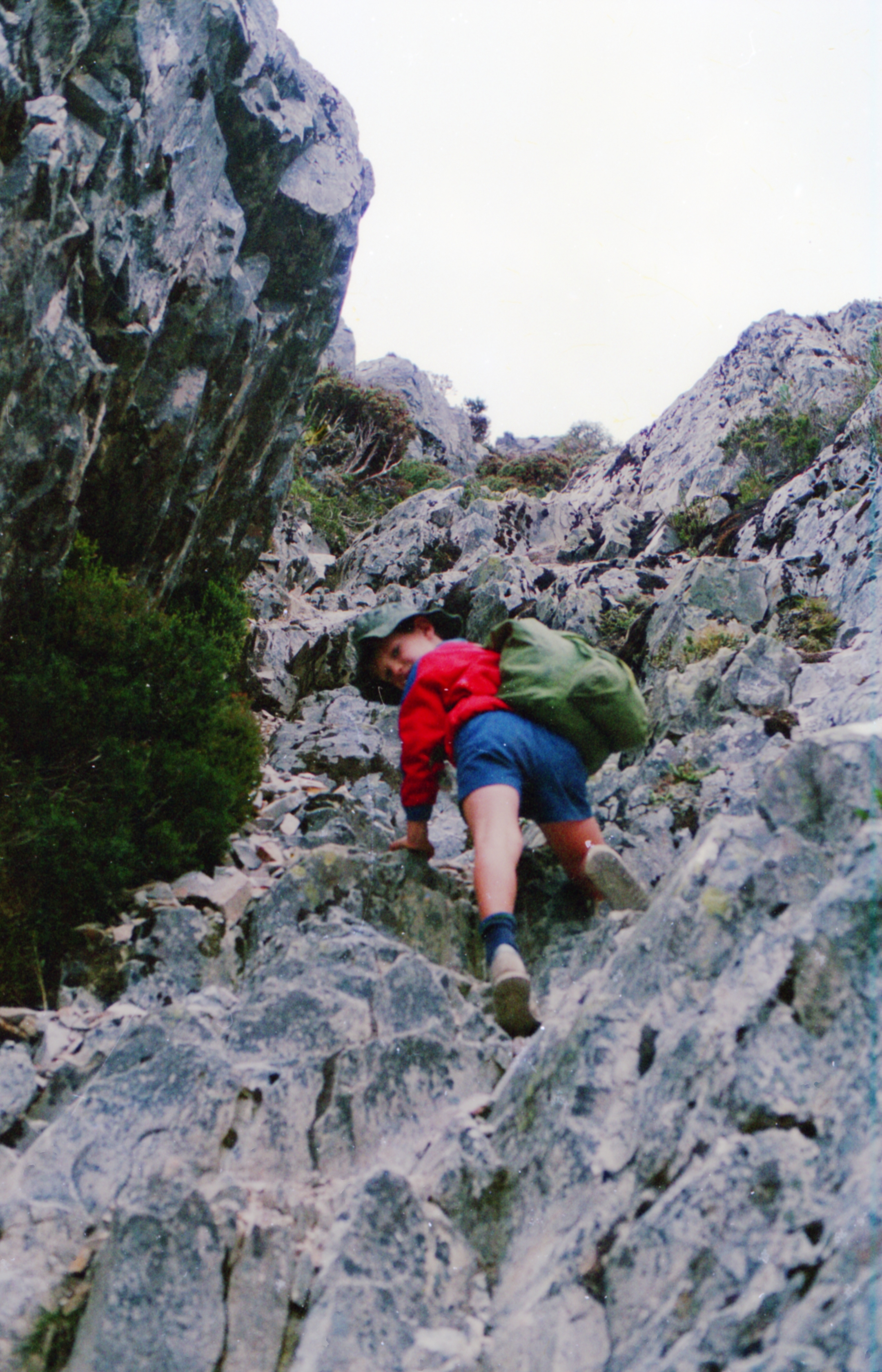
Reaching a saddle about 100m above Crater Lake we stopped for lunch of sandwiches and dried fruits looking down on the rugged beauty of the lake and valley below.
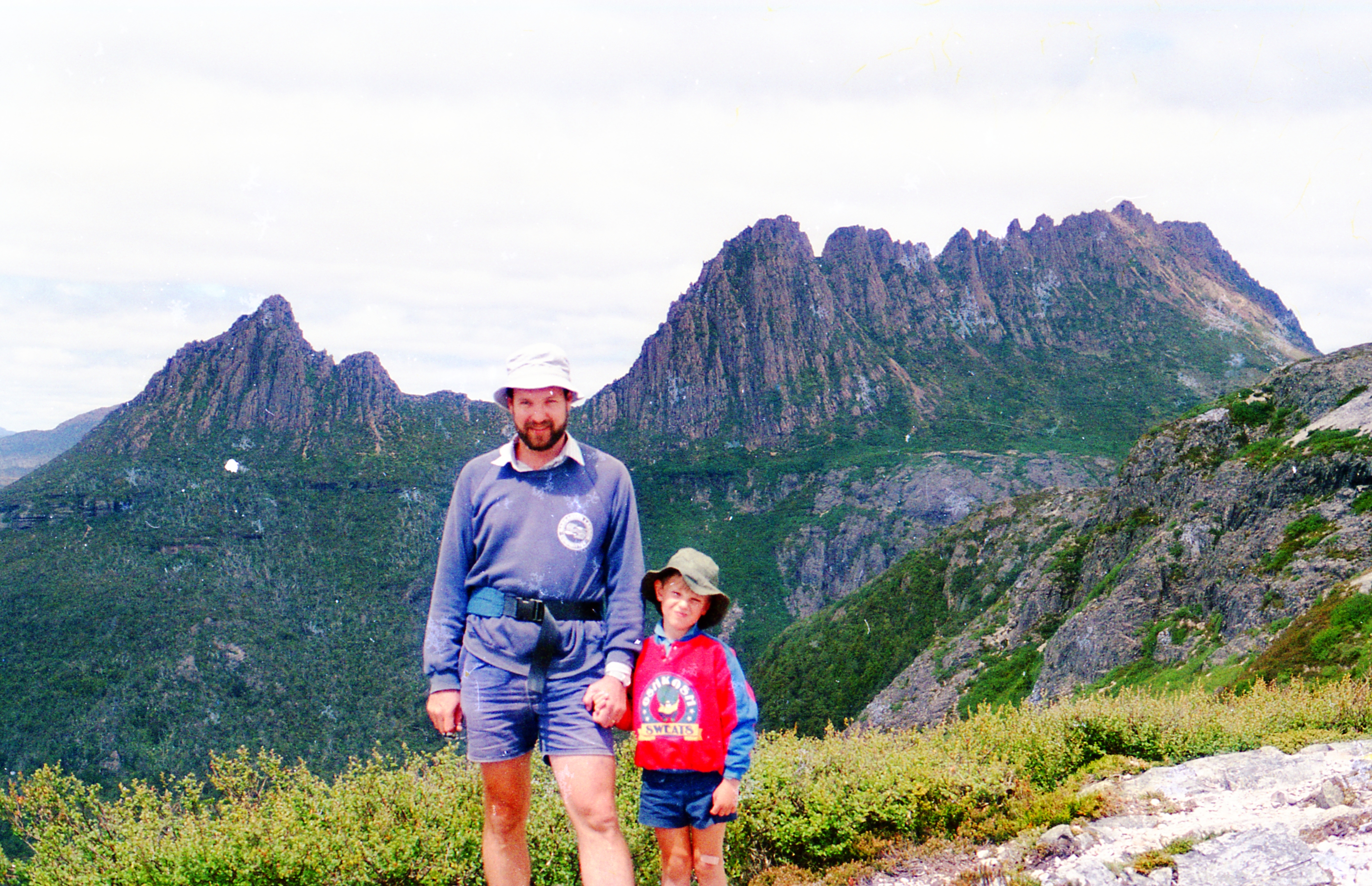
Lachlan was satisfied after only half a peanut butter and honey sandwich, so we turned to face what we expected to be our greatest challenge, the steep climb to Marion’s lookout, a further 100m up. Here the track was made of loose pieces of the metamorphic slates and phyllites which moved easily and made a sound like shovelled coal as we walked over them. The last 20m was close to vertical and involved climbing up natural steps in a narrow v-shaped cleft in the rocks. The view at the top was well worth it, however. A turn through 180 degrees gave postcard pictures of Cradle mountain, Cradle Lake, Waldheim and Dove Lake.

Walking down was more difficult than the ascent. After a short time your legs tell you they're not used to this and the loose scree slips readily away from your heavy tread.
Turning off our original track we returned to the car park at Dove Lake via Wombat Lake and Lake Lilla. Lachlan managed to step in a bog and sink up to the top of his socks. He carried on philosophically and tried to avoid the worst bogs for the rest of the walk.
At the car park we didn't wait long for a lift. We were picked up by a balding, bearded bloke (no - not me!) dressed in overalls, truckie boots and driving a Toyota troop carrier. He was employed by P&O, who lease the accommodation in and around the park, as a mechanic, fireman first aid officer and bus driver. A former resident of Cairns he said he enjoyed the cooler weather and lack of hard-sell tourist development: something that had forced him to leave Cairns.
Shortly after returning to camp Jacqui took Anja on a 40-minute walk to Cradle Lodge with the idea of posting a letter. The track, she says, wound through rainforest and is dark and lonely. Being boggy she ended up carrying Anja most of the way and was breathless when she returned for lasagne cooked in the fry pan using the power in the nearby camp kitchen.
Saturday 10th February 1990
Mum and Dad’s anniversary and Karen's birthday. I hope they all had a great day. Cheers!
Today was basically a transport stage between Cradle Mountain and Strahan.
Shortly after leaving Cradle Mountain it started raining and rained on and off, light and heavy for the rest of the day. We stopped for supplies at Rosebery and for lunch at Zeehan. At Zeehan we also paid a visit to a museum of trains and mining which was well worth it, displaying many aspects of mining, minerals, and railways in the west of Tasmania. We set up at Strahan around 6:00 PM expecting the rain to follow but we ate dinner outside. Also, there are 3 abalone boats, big shark cats with twin 225 horsepower outboard motors parked around the caravan park. I guess they have long days at sea, getting back to camp at around 7:30 PM. The police, who check catches, licences etc. have a fast-looking aluminium boat.
Sunday 11th February 1990
They didn't like it one bit, but it had to be done, after all it was for their own good! Besides unless we were to miss the Gordon Explorer on it cruise up the Gordon River, we just had to be up at 7:30 AM!
Rohan pouted enormously but we got there on time and Jacqui even washed her hair.
The girl at the desk of the ticket office was taken it back when I asked her for a ticket. Have you booked she inquired? No, I said, are there any spaces? Without a word she wrote out a receipt wrote our names at the bottom of a long list and drew a line through them with a pink highlighter. We were away. I didn’t understand why she acted as though there wasn't any room on the boat, as the whole lower deck was vacant.
As we motored down Macquarie Harbour in the sleek mono-hulled Gordon Explorer, the clouds began to break up revealing imposing mountains to the West. Before long the sun was shining, and we moved to the foredeck where a steel seat in the open air was a sort-after commodity. Nearly one hour after leaving Stahan the harbour narrowed and sandbanks appeared. We entered the Gordon River itself, slowing to 9 knots as we did so.
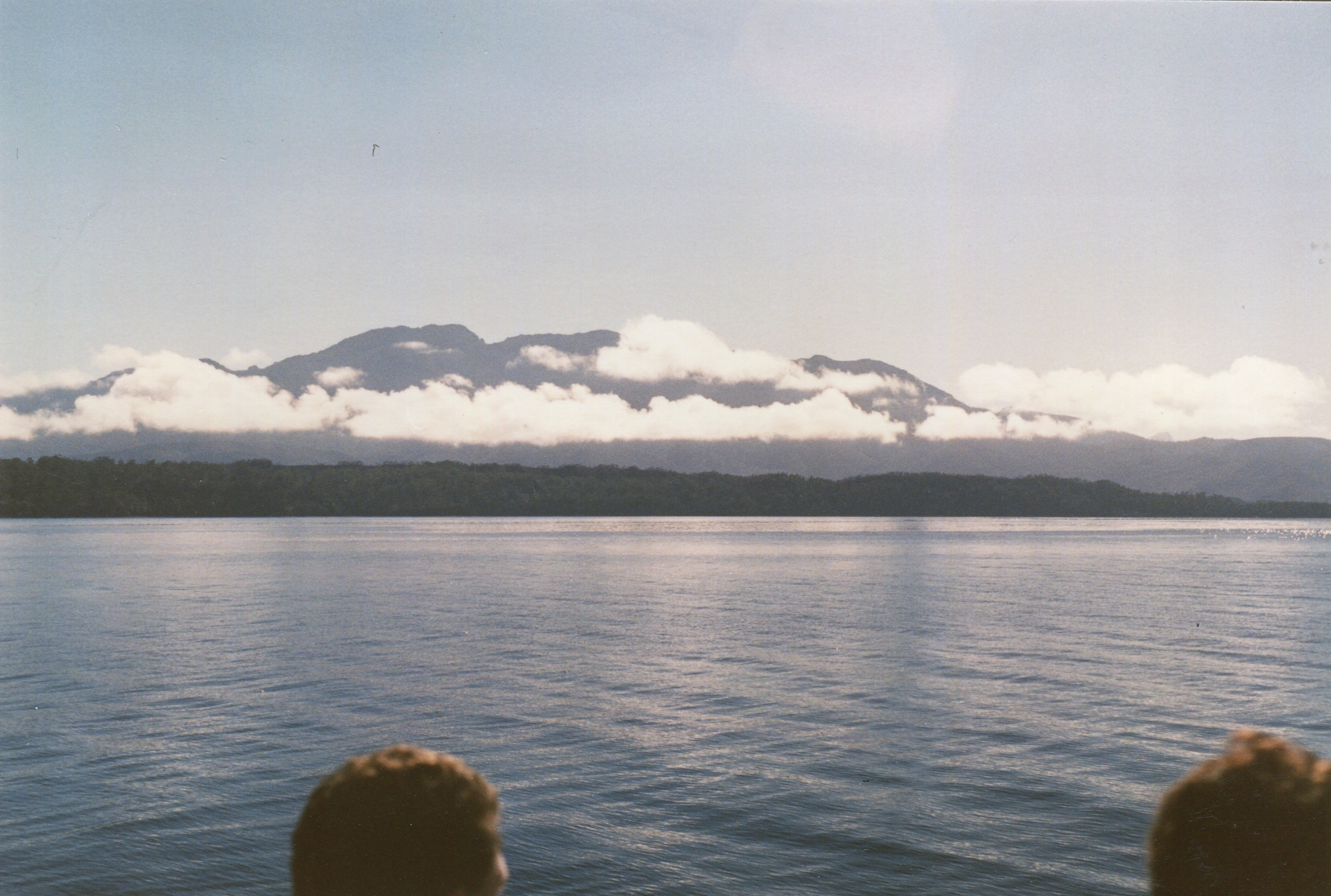
Steep sides, dark brown water that was 130 feet deep in places and a dense rainforest right to the water’s edge had the cameras of all on board busy. Even though mountains towered over us on both sides we were not destined to see the famed Gordon reflections, as a wind was studiously roughing-up the river’s surface.
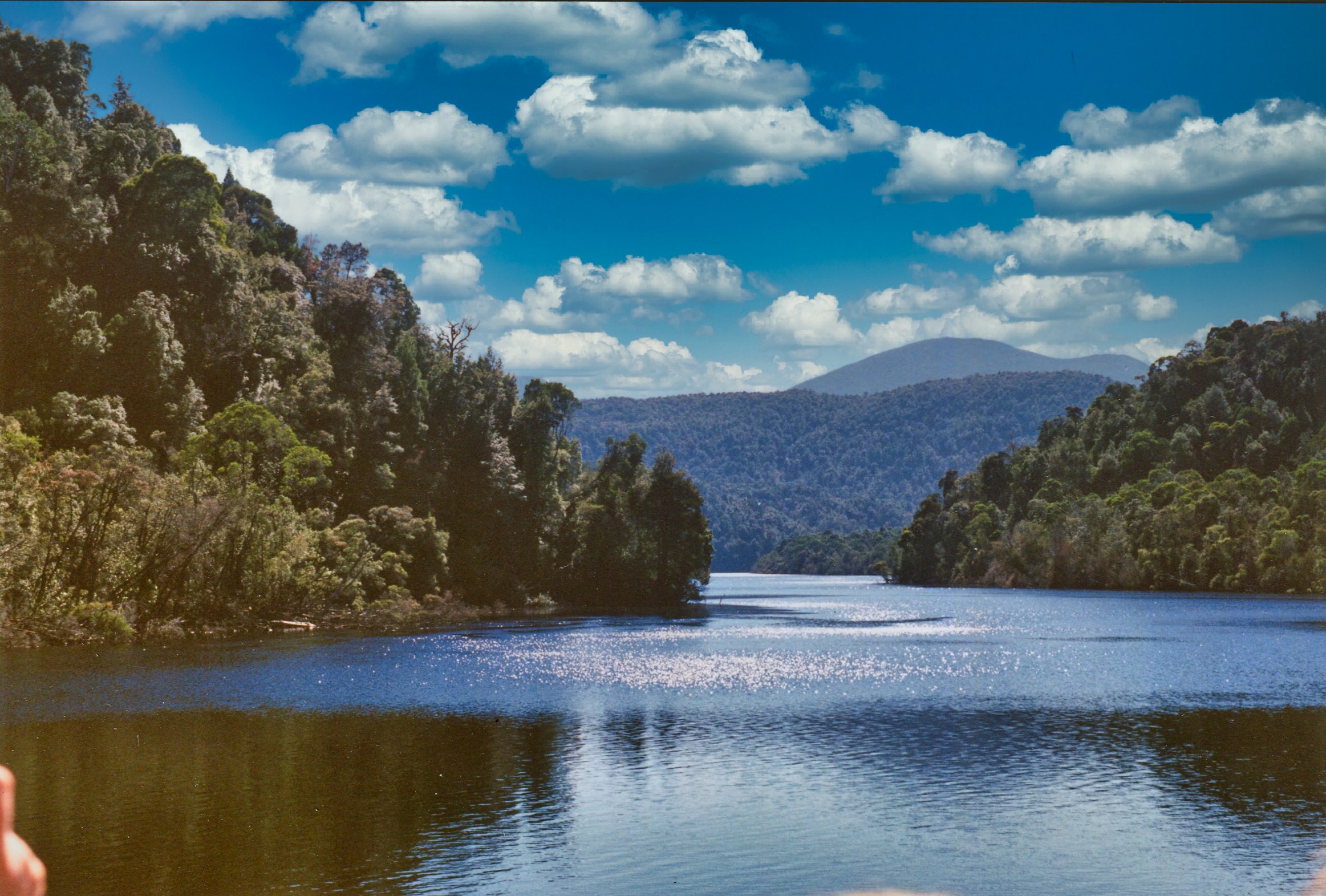
Throughout the trip the captain gave an informative commentary covering the history of the Gordon and surrounding areas, from its discovery by James Kelly in 1815 to the establishment of a penal colony at Sarah Island to gather huon pine for boat building - this area was exploited as a timber resource until 1962. He covered the confrontation between the greenies and the Tasmanian government in the early 1980s over the Gordon below Franklin dam scheme. He was biased against greenies says, Jacqui. He certainly seemed pro-dam to me: a strange stance as I'm sure a large proportion of his business would be derived from people who had heard of the area during the tussle and now wanted to see for themselves. He did point out that this cruise was the single most popular tourist destination in Tasmania.
Apologies for going a little crazy with this video :)
As an aside the airline dispute, that began in late 1989 where pilots were striking for increased wages, was costing his company heaps. They have three similar vessels which, pre-dispute, ran each day. Now 2 sit idle at the dock, skippers and crews laid off.
As a trade-off, to limit the distance up the Gordon River reached by the tourist boats and to limit the destructive affect of their wakes, National Parks has built an elevated walkway and landing so that tourists can see the rainforest and some huon pines close up. They have even started to feed the local pademelons or Rufus wallabies as a tourist attraction.
Huon Pines are unremarkable looking trees, they are slow growing taking 200 years to increase their diameter by 2½cm, with a gnarly trunk and scraggy foliage.
Back into Macquarie Harbour and on to the aptly names Hell’s Gate - the entrance to Macquarie Harbour.
Hells gate is about 100 metres wide and when the Gordon River is in flood can have a current approaching 18 knots flowing seawards. A 2km long training wall was built at the turn of the 20th century to help keep the channel deep and clean by directing the tidal flow.
Back at camp by about 7:30 PM we bought pies and chips for lunch and spent the rest of the day at leisure. The kids had a great time swimming in the Harbour despite the cold water. Lachlan spent 1½ hours playing on an improvised water slide made from a section of conveyor belt supported by a simple wooden frame. Before long he was an expert, careering down on his knees, producing a wall of water when he splashed down into the water at the bottom of the slide.
Sausages for dinner cooked on the barbie by our expert cook Lachlan.
After chatting in the laundry, Jacqui bought over Ailsa and Mark Brewer to talk to Ian. Mark is a vineyard manager. They invited us to visit the vineyard near Launceston, Piper's Brook, that Mark manages on the 27th of February. [2020 note: here is an article on Mark’s career]
Monday 12th February 1990
Another moving day saw us leave Strahan around 11:00 AM for the 37Km trip to Queenstown. With van in tow we took close to one hour before the barren yellow-orange hills came into view. Stopping to eat lunch in a park a cast copper sculpture told us part of the history of this mining town.
When we finally left it must have been close to 2:00 PM. The road out of Queenstown winds up the sides of the bare Hills and gives, at the top, a view of the town and the folded strata from which the mine reaps its bounty.
At times while on the West coast I wish that I had absorbed more of Dr John Lusk’s course at Macquarie University, Geo 390 Ore Deposits. Had I done so I would have been better able to answer Jacqui and the kids questions about the mines we were passing.
The road to Mount field National Park wasn't all that long, only 210 kilometres, yet it took what seemed like an age because the road rarely goes in a straight line for more than 100 metres at a time.
We broke our trip around the middle for a walk by the Franklin River, in the cool mossy rainforest with which we are becoming familiar.
Shortly before turning off through Ellendale and Westaway, the nature of the country changed. Steep Hills gave way to rolling planes, the trees became a much more open. At time we could have been driving around Orange New South Wales. I learned later that in this area 12 inches of rain is an annual average rainfall total.
When we pulled into this self-register camping area at Mount field we were surprised and pleased to see Mark and Ailsa Brewer. We had a choice, a powered site with dirt next to mark and Elsa or an unpowered site on grass. We chose the site with power and friends. That night after the kids went to bed we had an interesting campfire conversation with the Brewers [2020 note – for some reason I did not record what the conversation was about :( ].

Mt field National Park. The tall trees provided a home to cheaky possums as well as a scenic camping spot.
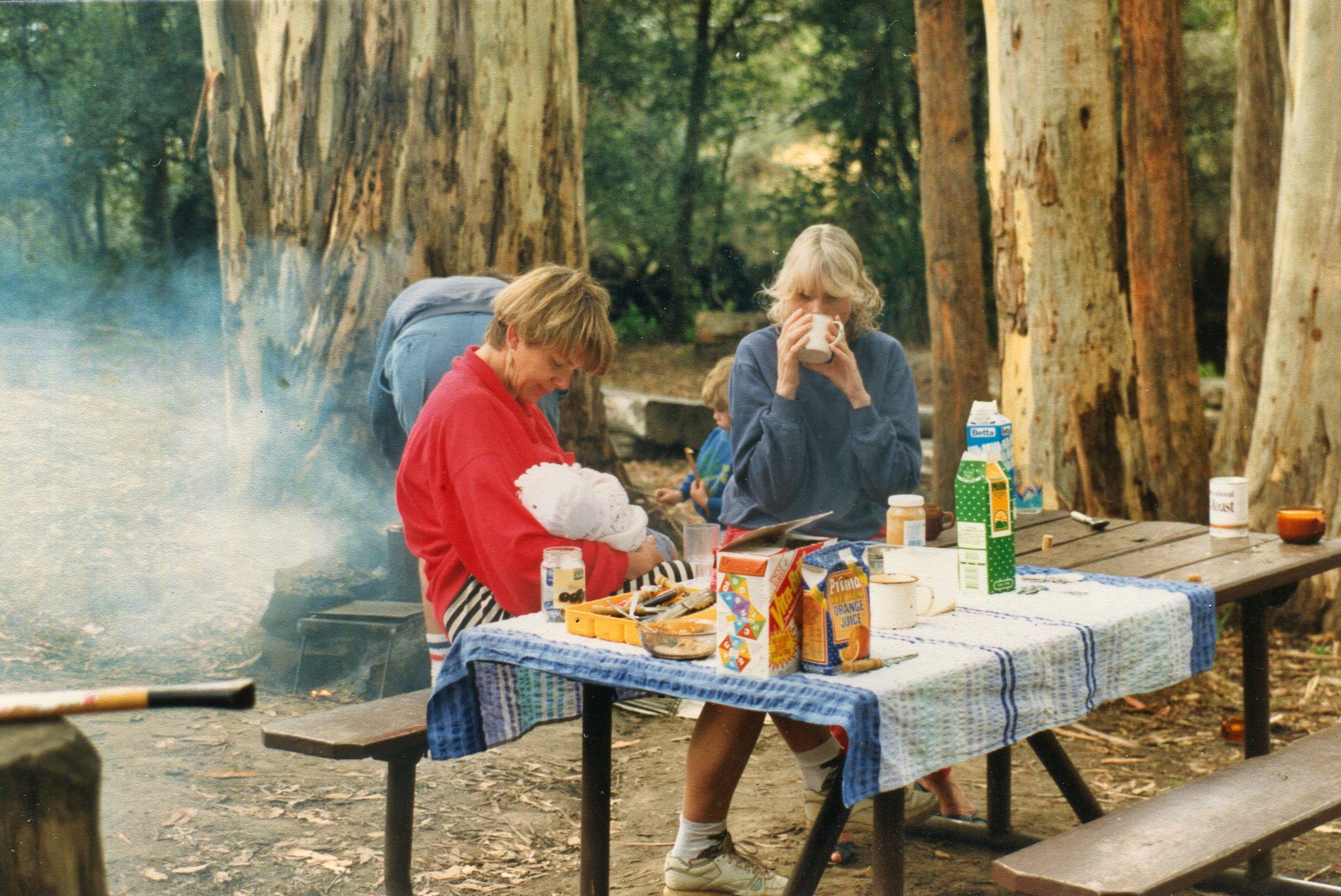
Ailsa Brewer, her daughter Amy and Jacqui at breakfast. That's me tending the fire.
Mark Brewer photo
Worthy of note are the incredibly bold possums. One climbed up the steel poles which hold up the annex and onto the van roof while the others had to be swatted away from our biscuits. They had no fear of or respect for humans, even knocking down all the garbage bins looking for food in what appears to be a night nightly ritual.
Tuesday 13th February 1990
The Ranger’s morning ritual is to fix up all the bins knocked over by the possums the previous evening. The Tyenna River, which runs by our campsite, is alive with trout. They can be seen jumping to snap up insects which land on the mirror-like water surface or by their shadows moving over the brown rock-strewn riverbed.
After rigging up two rods I tried to spin for trout, but they didn't even pay any attention let alone bite!
Hanging around the kids throughout the morning was a baby rufus wallaby which followed them doglike, eating and drinking willingly. Jackie was concerned that it was too thin to survive and the fact that it curled up comfortably in the fold of Jackie sloppy joe also suggested it may not have been wild. When she took it to the Ranger he called in someone who had hand-rears these beasts and having examined the little creature, agreed to look after it. Jacqui 1 nature 0.

This little rufus wallaby followed the kids around all day. It was probably hand reared and released too early. Jacqui returned it to the Ranger who organised to have it taken back into care.
Mark Brewer photo
After lunch we packed into the wagon and took the high road to the top of the park. And a long winding road it was too! During the climb the vegetation changes abruptly from one type to another and finally to scattered trees with extensive rock falls of dolerite boulders.
We spent a few hours fishing in Lake Fenton without success, in fact the lake came off best with one extra lure embedded in the bottom. The handle of Dad’s fishing reel also was claimed by the Lake but we retrieved it with Lachlan's rod with lure triple hook at the end.
Anja using her imagination more successfully than the rest of us used lures!
Back at camp we walked by the River after dinner that evening. I asked a couple who are about to have dinner whether trout had been jumping onto their plates? When I looked at them as they replied I found I was talking to Dr John Lusk and his wife Ruth. They had been walking the overlanded track and will be catching the same sferry back to the mainland on the 27th of February.
They were not the only people we recognised. We keep seeing the same people as we travel from place to place in this state.
Wednesday 14th February 1990
After a morning spent terrorising the trout we packed lunch and headed towards Strathgordon, Lake Pedder and the Gordon hydroelectric scheme.
Our first stop was a 20-minute circular walk in a rainforest area. Of interest here was horizontal scrub which, true to its name, produces impenetrable scrub of arm diameter trunks which lie more or less horizontal from ground level up to 2m.
The views which unfolded as we continued were of rugged mountain ranges in all directions. They were particularly spectacular because of the stark jagged peaks some of which were aptly named the Sawtooth Range.
Just before Strathgordon we came upon Lake Pedder. Impressive due to its size, even though only part of it could be seen at any one time because of the embracing mountain ranges .
Stopping at an old disused camping ground come day picnic area on the shore of the lake we ate lunch and enjoyed two further hours trying to stun more trout. Jacqui knew they were there and was determined to catch at least one. Lachlan has developed a good arm for casting and will do even better when we buy him a new reel.
Sorry Ian, wrong date - it was Wednesday 14th February, but it doesnt really matter does it? It was still a nice place to learn how to fish!
Strathgordon is a typical Hydroelectric Commission town having seen better days during the construction phase of the dam.
As we travelled the 13 kilometres to the dam itself, Lake Gordon came into view on the northern side of the road with like Pedder to the south. The lake’s level was 10m below high water and between the water and lush green of the undisturbed vegetation is a band of ghostly naked trees standing firmly where they had died as the water rose in the mid-1970s.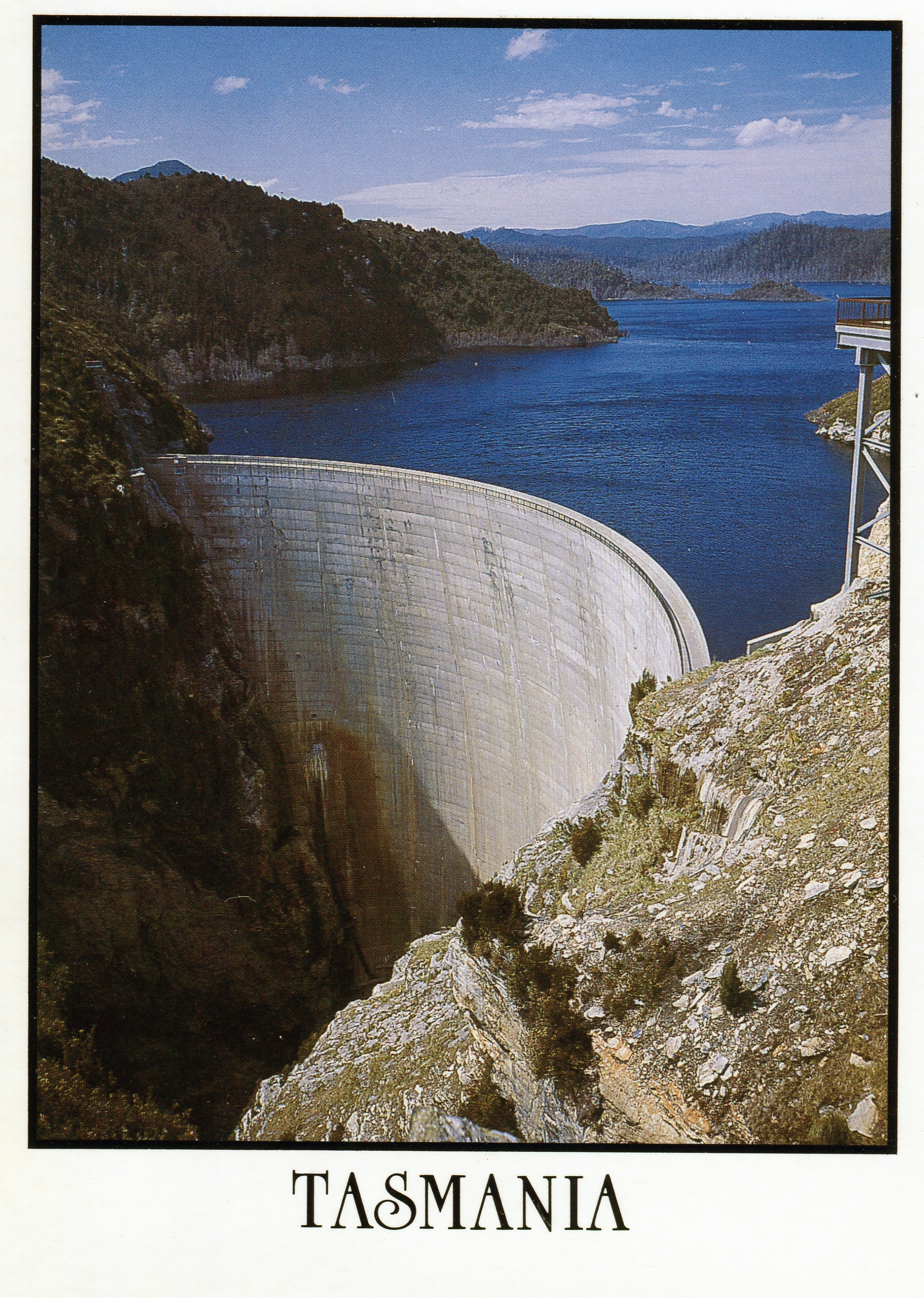
The Gordon Dam, also known as the Gordon River Dam, is a major gated double curvature concrete arch dam with a controlled spillway across the Gordon River, located in South West Tasmania, Australia. The impounded reservoir is called Lake Gordon.
Parking the car in the car park (yes that is a strange thing to do), we walked to the reception area or tourist trap need the dam wall. The dam wall itself is a graceful arc across a vertically sided valley of the highly folded pre Cambrian metamorphic rocks revealing their structure along the sides of the valley.
Soon we boarded a small 15-seater bus for the 1Km ride down the steep access tunnel to the power station viewing area. The tunnel was necessarily large with thin, white stalactites hanging from the ceiling.
The power station produces enough electrical energy from its three turbine/generators to power Hobart. Mostly power is produced by only two generating sets, the third is used for peak demand times. Space has been left for two future sets if demand increases. The pipes which deliver water to the turbine must be at least three metres in diameter.
Petrol it Strathgordon was cheap at $0.67 cpL on our way to a different part of Lake Pedder for another hour of fruitless fishing, before heading back to camp.
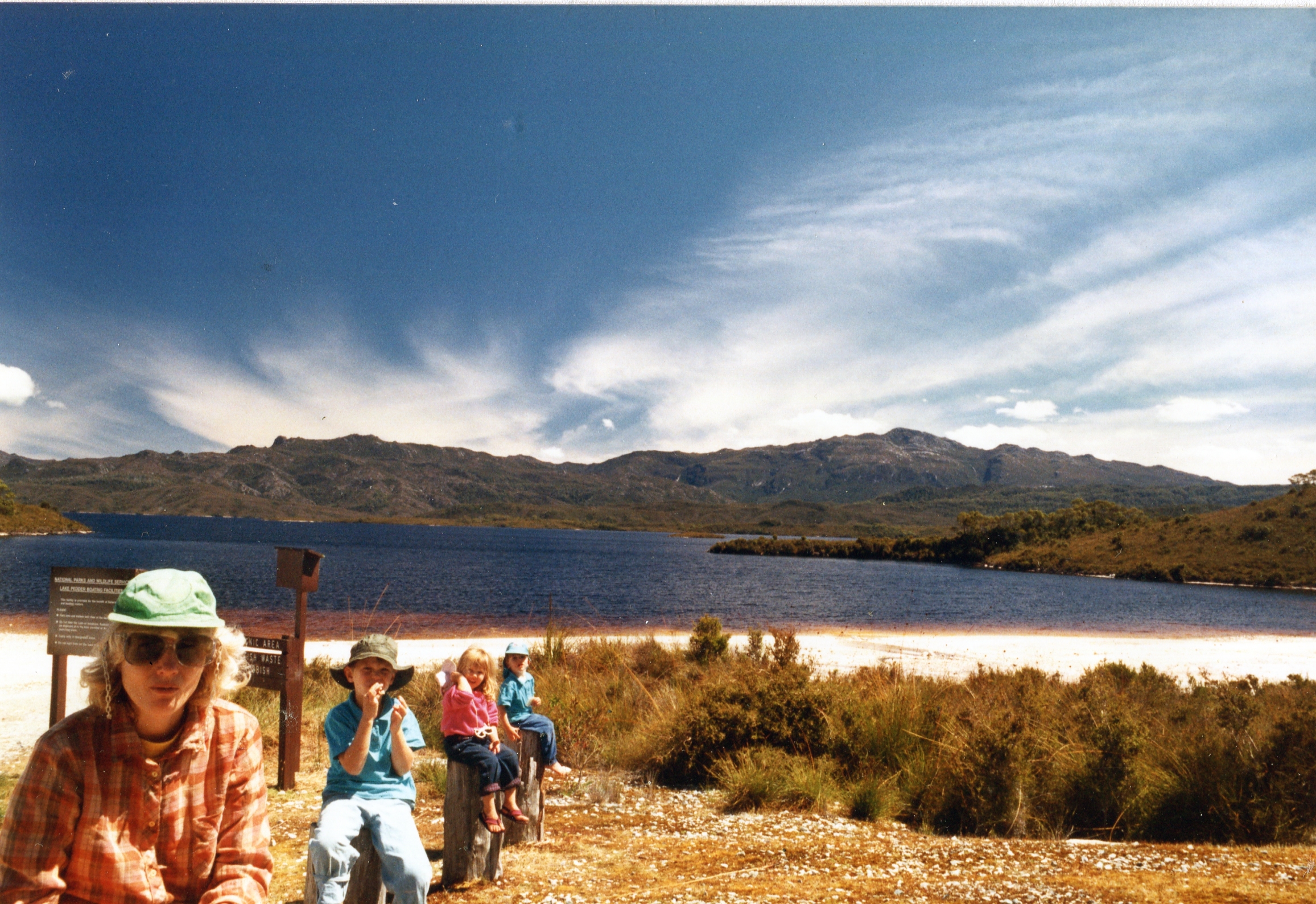
Lake Pedder had failed to yield any of its trout, hence Jacqui's unhappy visage
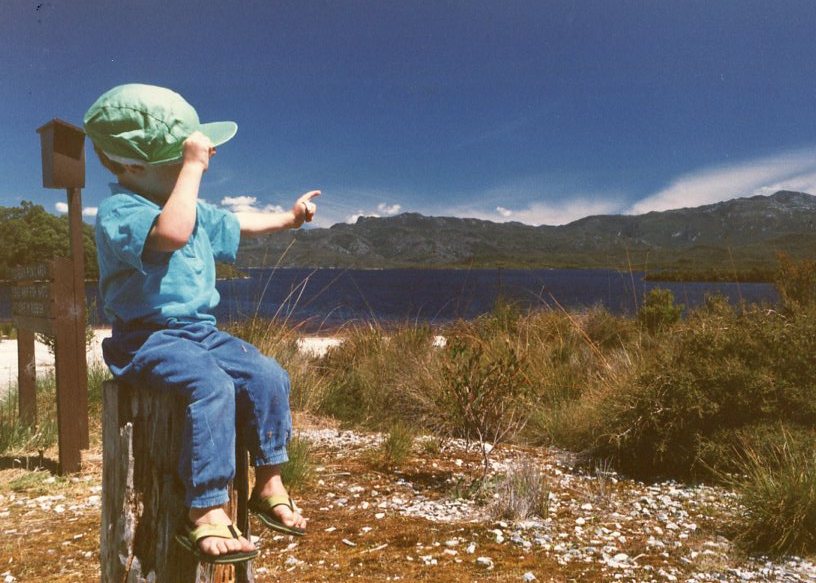 That's Lake Pedder.
That's Lake Pedder.
We were puzzled by the large numbers of dead trees protruding above the canopy and resolved to ask a Ranger about why they were there.[2020 note - we never did ask a Ranger, but most likely they remain from a previous bushfire]
Thursday 15th February 1990
The kids did some fishing in the morning and proceeded to lose several lures. This was usually because Lachlan let them sink to the bottom before beginning to wind in. After replacing lure number 3 I decided enough was enough and put on wet suit, mask, snorkel and booties and went for a swim. I found the water to be cold, but my wetsuit did an excellent job with only my hands feeling uncomfortable and that soon faded. The water was clear, so I soon found several silver lures in crevices on the rock bottom. In fact I found about 6 in all, unfortunately only 1 of them was lost by Lachlan.
People had fished in the river for good reason though, as brown trout were lurking in most cracks and beside the bigger boulders. They would allow me to reach out until my hand was a tantalising 2cm away from them and just as I was about to grab, they would dart off in a cloud of stirred up silt.
After lunch we walked down to Russell Falls trout farm. $2 gained entrance and we wandered around the many dams stocked full of trout in various stages of development. The most impressive were the brood stock - large trout kept for breeding because of they either grew rapidly or were disease resistant. After watching a video on the operation, we spoke to a couple from Gordon New South Wales, about the ins and outs of children. We soon found they were catching the same return ferry on the 27th of February.
The water returning to the Tyenna River from the farm was smelly and had numerous escapees swimming unafraid. It occurred to all of us that they would be good to catch.
Having taken advice from the shop owner we collected rods and gear, walked along the railway track to the river downstream of the trout farm. I fished with bread and Jacqui with lures. Jacqui only fished for a short time as she saw a snake near Lachlan. I walked further upstream closer to where the water from the farm ran into the river. I saw numerous fish and a few eels, but none seemed interested in being caught. All I got from my troubles was very wet when I slipped off a log into deep water.
We had more success with blackberries however and had half-filled a small bucket within an hour or so.
Even though it was an uncharacteristically hot, clear day, as soon as we entered the rainforest on the way to Russell falls it became cool with subdued green light. The falls themselves were impressive: water cascading over three steps down 50 metres in total. When the weather is more normally wet these falls would be even better.
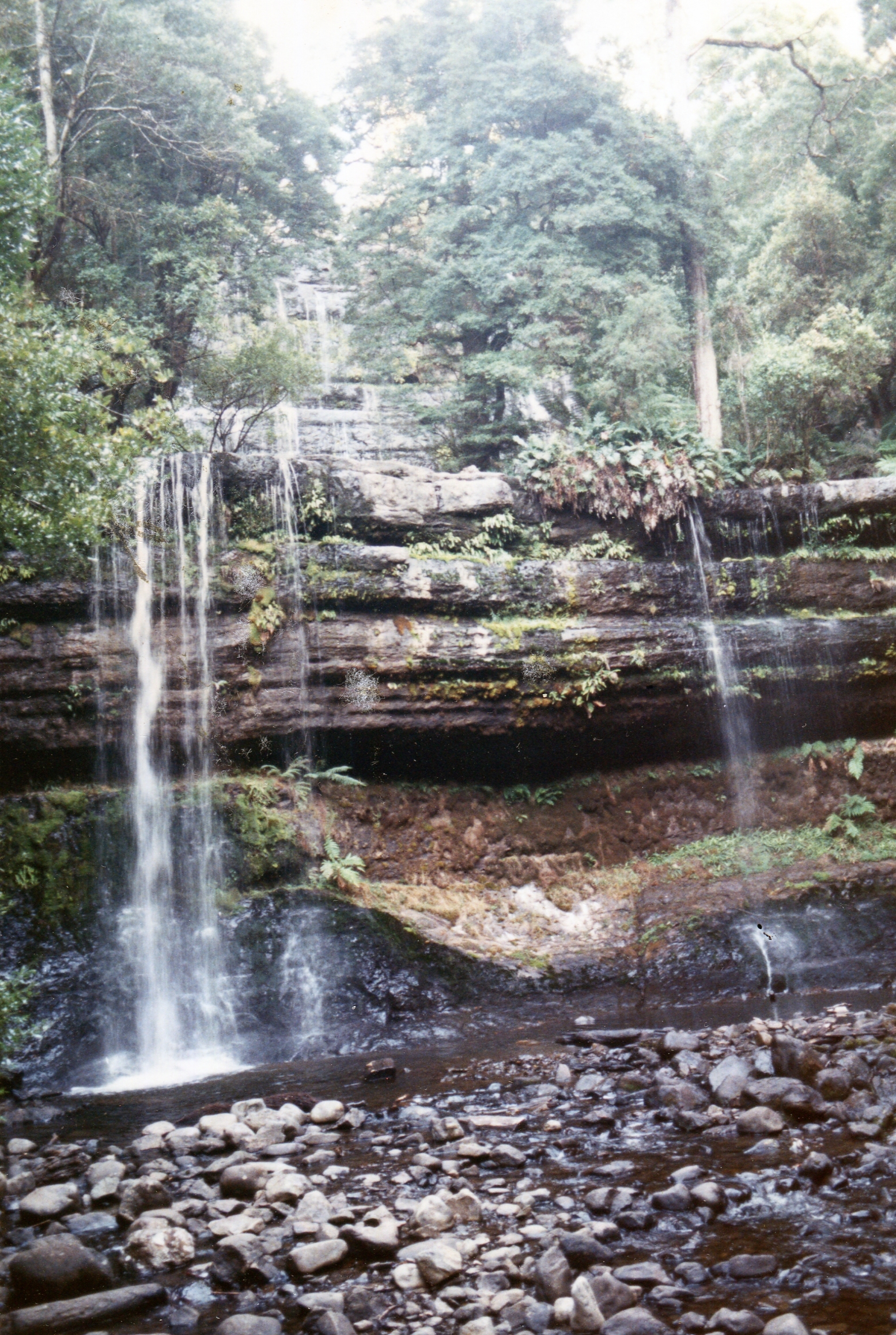
Russel Falls in Mt Field National Park
To walk to the top of the falls took about 10 minutes up stairs made from the trunks of old tree ferns. At the top we were greeted by cold air which was draining down the same valley as the river.
With the kids finally in bed and Jacqui returned from an unsuccessful 2-hour fishing trip using flies. We opened a bottle of champagne with our neighbours Andrew and Linda Pfitzner. They had been married last Saturday and were on their honeymoon driving a Hertz motorhome around Tasmania for eight days. Andrews father owns a furniture making company and when he showed us a brochure we were impressed by the quality and price of his Australian timber to pieces.
Andrew and Linda must either have strict puritanical parents or South Australia is a few years behind the times in terms of premarital relationships. Andrew and Linda commented on the strange new experience of having another body in your bed. Try before you buy wasn't their motto!
Friday 16th February 1990
Packing up took longer than usual as we needed to organise clothes and other things to enable us to sleep in the tent that evening at Port Arthur. [2020 note – I’m not sure why we could not have setup the van]
Finally, heading off around 12:00 PM, we travelled through dry sheep country. Drought and overstocking had left many paddocks free of any feed whatsoever. Very un-Tasmanian! Along the banks of the Derwent River were many hop farms with their characteristic tall trellises hidden behind rows of poplars.
Hobart sort of crept up on us and before long we were on an expressway travelling through the northern suburbs beside the Derwent River.
In town we got money from the Tasmanian Teachers Credit Union and nearby, we were able to purchase new rubbers for my speargun. In town I drove around the block so Jacqui could check to see whether the correspondence school had said sent anything for lachlan. We managed to get our wires crossed and lost each other. [2020 note: we must have been able to find each other again]
A quick grocery shop and another trip to town for a Bankcard [2020 note: Bankcard was the first credit card in Australia] payment and we were off over the Tasman bridge headed straight into a town where we didn't want to be. A few rushed U turns later, and even more rapid lane changes and we were headed for Port Arthur. It took longer than we thought but we eventually arrived at Port Arthur at around 6:30 PM.
Unusually we ate out at a family seafood restaurant 10 kilometres North of Port Arthur. We were greeted by the waitress:” Do you want to sit down to eat? We were going to close early!” Jacqui replied, “Your sign said dinner 6 till 8.” Waitress “I'll check.”
After this amazing display of indifference to paying customers we had excellent seafood baskets all round. The kids behaved remarkably well….until their bellies were full!
In the twilight we put the tent up in the Gordon Point caravan park (rated at four stars for $10 per night) and started to blow up the necessary three air mattresses. One by one they soon revealed a singular lack of air tightness. In the end only one held air!
The thought of sleeping on the ground didn't appeal to us so we decided to remove one of the phone beds from the caravan. It was at this point I discovered that one of the corners of the van wouldn't go up. While removing the mattress I held up the problem corner with a file. Eventually we got off to bed and slept well.
Saturday 17th February 1990
Although we had less to pack away with the tent, we left the park at 10:00 AM having risen at 8:00 AM.
First stop was Remarkable Cave which lived up to its name, being a sea eroded cave and a vertical sided valley in a strange banded igneous rock. The bands’ folding reminded me of the effect of gravity tectonics in the limestones at Wee Jasper.
Five kilometres and $11 later we parked in about 5 car park spaces at Port Arthur before joining an excellent tour. During the next half an hour the guide gave an excellent commentary on the history of the penal settlement some of which I got on video. The buildings and setting of Port Arthur are spectacular but is the history associated with them that makes a visit worthwhile.
For lunch we ate cheese and bread, sharing a table with three people from the University of Queensland who had been presenting papers at the ANZAAS (Australian and New Zealand Association for the Advancement of Science) conference in Hobart. The two men had given a paper on the greenhouse effect and tourism. The lady gave a paper relating food technology to the greenhouse effect. Jackie found them intensely interesting and pumped them for information as much as good manners would allow…and then some![2020 note – I’ll bet those people are feeling depressed and saying “we told you so”, 30 years after that conference and nothing having been done to address the cause and alleviate the impacts of climate change]
We “did” a few more ruins after lunch until the kids started to get edgy. By now it was raining which didn't help much. Judy Marlow’s raincoats were worn with great enthusiasm by the troops and gave sterling service as well as allowing Jacqui and I to use the brollies.
Afternoon tea of tea coffee and hot chocolate cost us $6 before we headed for the toilets. From here Jacqui returned to look at more buildings. The kids and I wandered up to the wharf where four men were fishing. Their large tackle boxes contained every conceivable item of fishing equipment and then some. One of them caught a small pike and used it as shown in the diagram below.

We saw the cork move violently and the pike was retrieved, or at least the front half was, where back half went, we could only guess. What was consuming most of the fishers' time was trying to catch a trout that was a lurking under the wharf having escaped, with about 9000 others, from a local fish farm. They had no luck as we didn't have a fish food shaped lure.
A few kilometres down the road we stopped at the Devils Kitchen and Tasman Arch. Impressive erosional features controlled by joint orientation. We met up again John and Ruth Lusk and spoke at length about taking over the world and what we would do if such an event ever came to pass.
Our original plan was to drive to Coles Bay, but, as we took a shortcut involving 26Km of very narrow, winding, and muddy road it took us longer than the long cut! We settled instead for a beachside site at Orford in the same camping ground at which Jenny Chalmers, Lauchlan Giddy and I stayed in 1977 while touring Tasmania by motorbike.
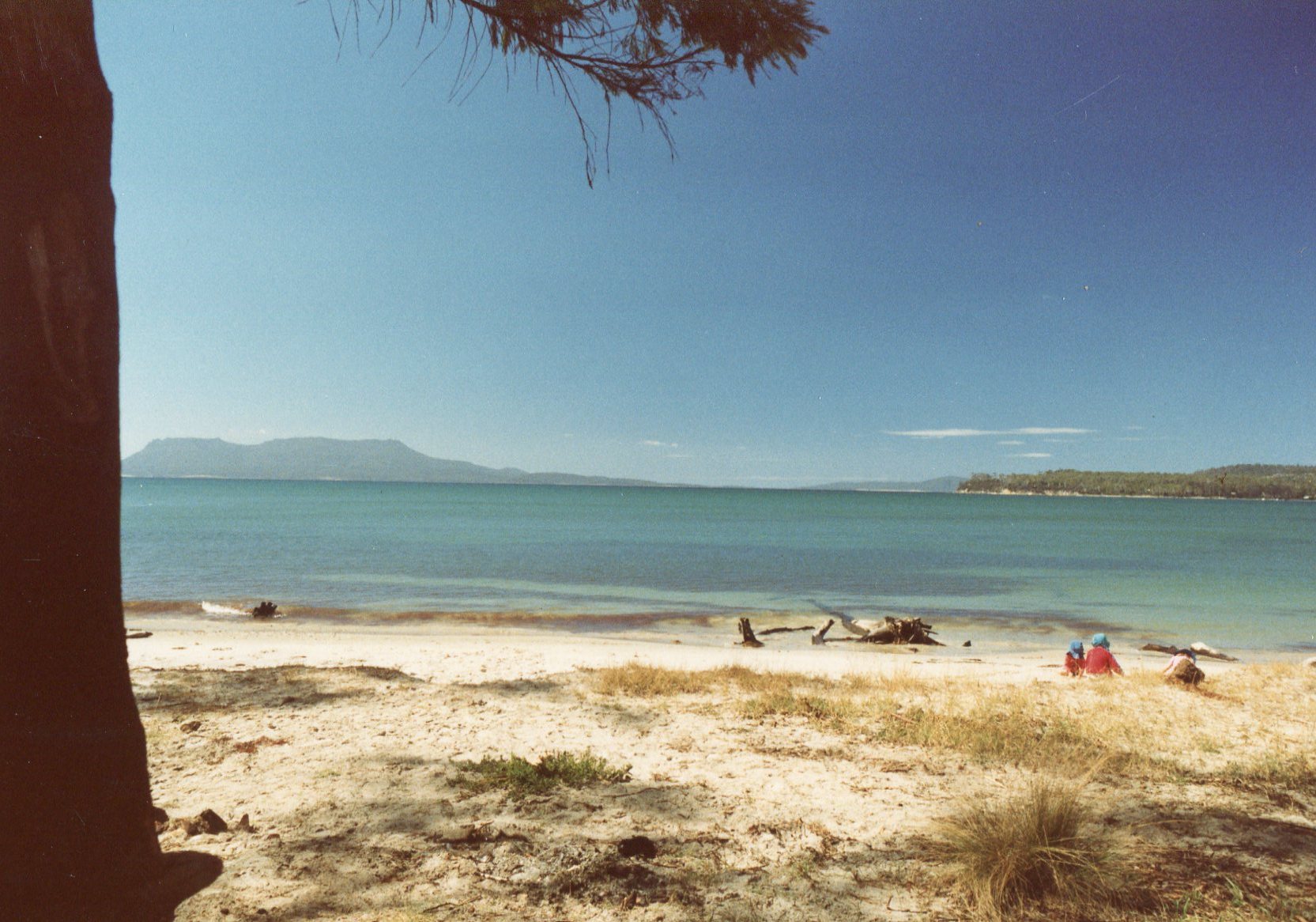
Our campsite at Orford right on the shore of Prosser Bay
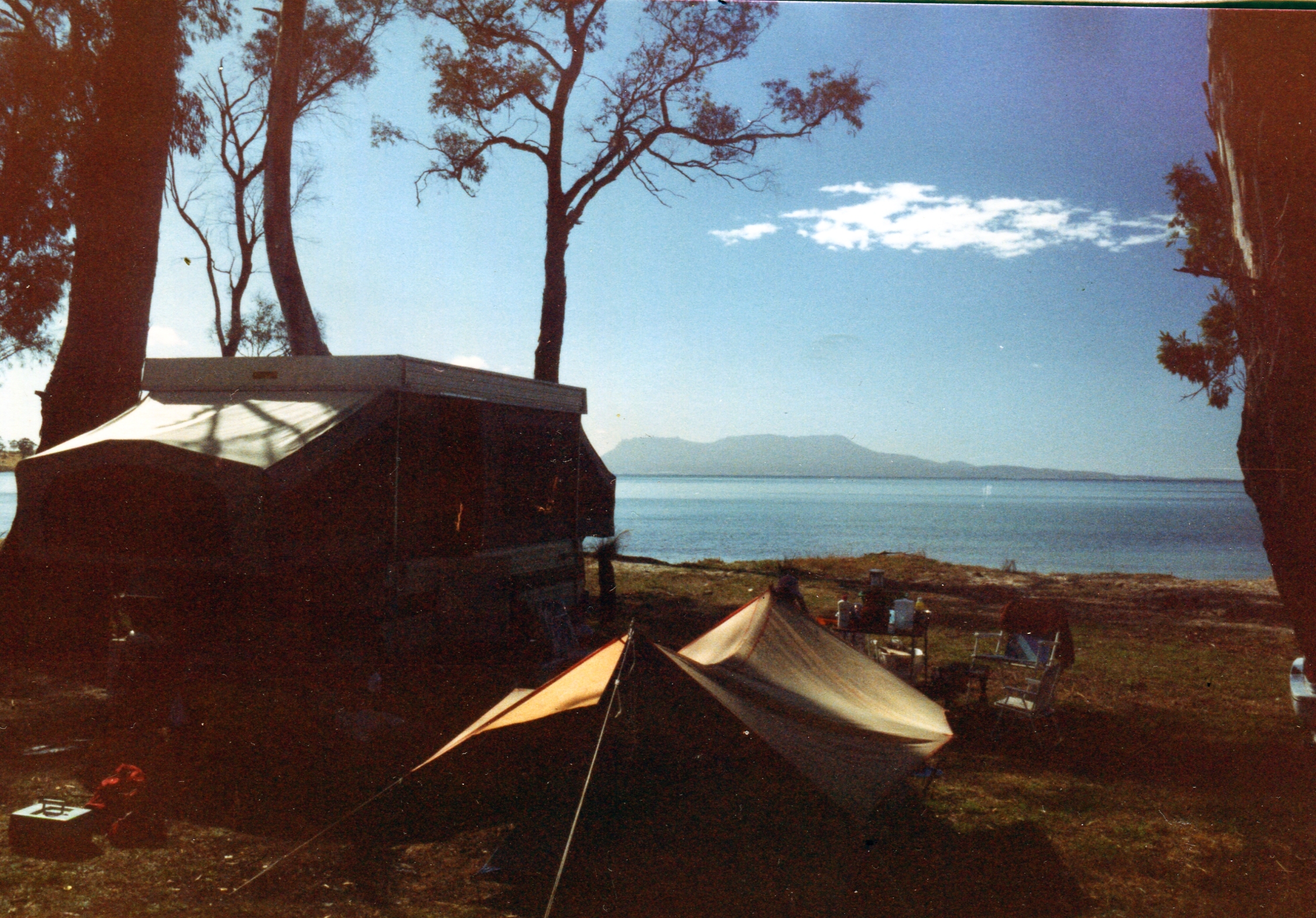
While staying at Orford I had to fix a faulty cable that pulled up one corner of the van. A temporary fix was to hold up the corner with a tree branch.
Sunday 18th February 1990
Instead of feeling my body heat slowly seep out of the end section of our caravan, this morning I awoke to the warmth of the sun. Being the only one up I walked by the road into the town (Orford) for milk and bread at 8:00 AM. The trip back was via the beach with Maria Island misty under the newly risen sun.
We spent quite a while repacking the van and managed to squeeze a lot more into cupboards etc. giving us more space and less to pack each time we move. So, it was just after 12 before we were on our way to Coles Bay. In general the road was good, meandering through open grazing country with views of the Freycinet Peninsula and Schouten island in the distance. Even though it dawned clear a strong NW-SW wind brought with it occasional, brief showers of rain.
The last 20 kilometres were the most difficult of the trip as Lachlan led a loud chorus of “I’m hungry” as well as pulling my seat belt as tight as he possibly could. The latter as a form of punishment for me as I refused to stop for lunch when he wanted.
Deciding washing machines, hot showers and a laundry were more important than greenness, we opted for a new commercial caravan park, rather than the Freycinet National Park a little further down the road.
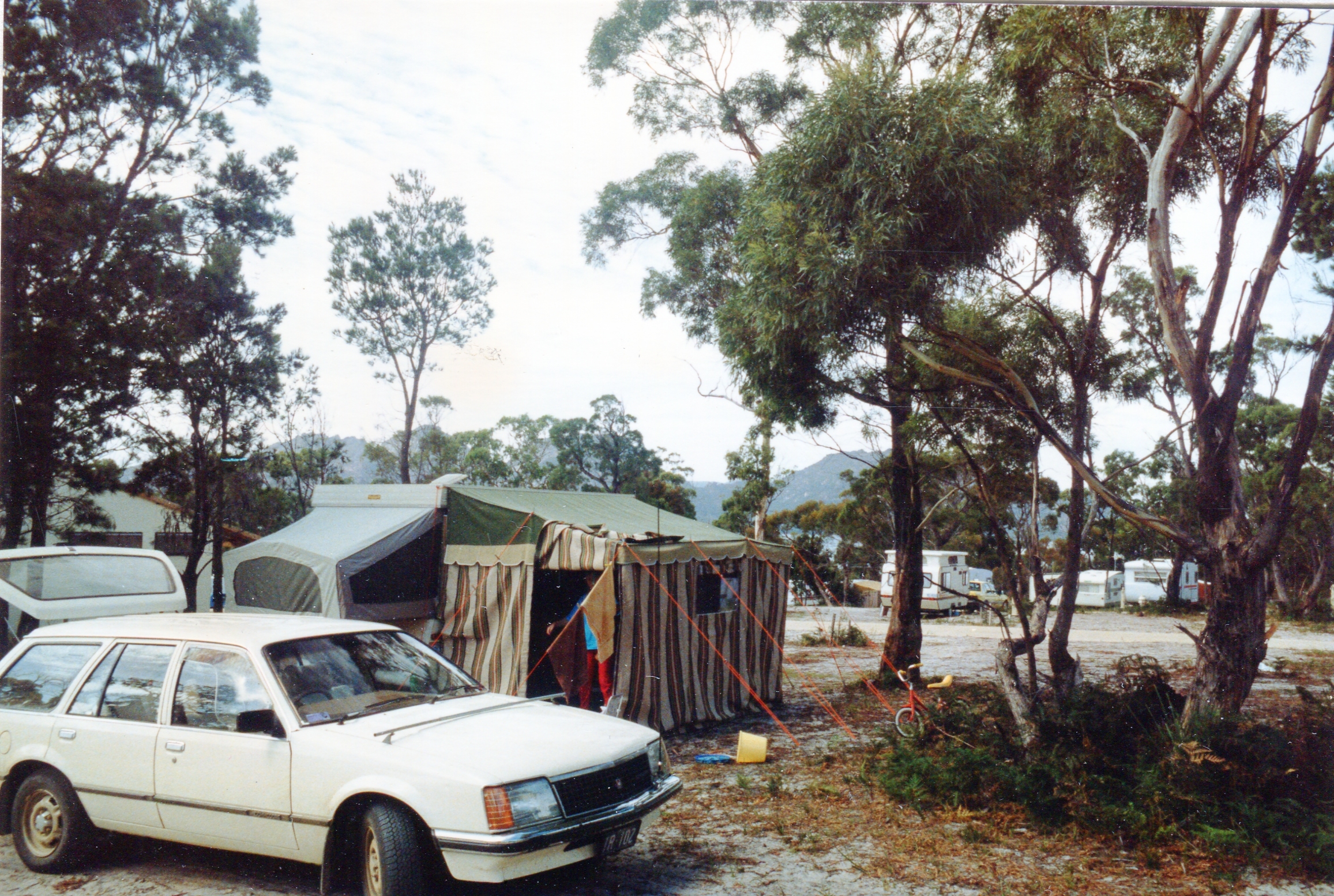
Coles Bay campsite. The park was brand new with little if any grass covering the grey humus rich sand we've become accustomed to in beach-side caravan parks and camping reserves.
Immediately on arrival we ate lunch, which silenced Lachlan’s cries for food but appeared to make no impact on his cries of anguish when asked to assist in setting up camp.
Making use of the laundry and three washing machines at once, we had the washing out to dry and were on our way to Bluestone Bay by around 4:00 PM.
The 6-7Km trip was dirt road and rough, especially for the last 1-2Km. Fortunately, sheltered from the strong SW wind by the high granite peaks, the sea was almost dead calm. After entering clear but cool water I spotted a big red mowong, pointed the gun and pulled the trigger. Nothing happened! After attempting to fix the trigger mechanism with my knife I decided to head back in for repairs. On the way I spotted some abalone and collected 5. Jacqui called out that there was something there in the water with me. Here is a diagram of what it looked like to her.

It took a long time to fix the faulty spring in the trigger but eventually I got back into the water. The fish must have known I was coming because they were all hiding amongst the kelp beds. I saw and shot 1 red mowong, a leatherjacket and a trevally.
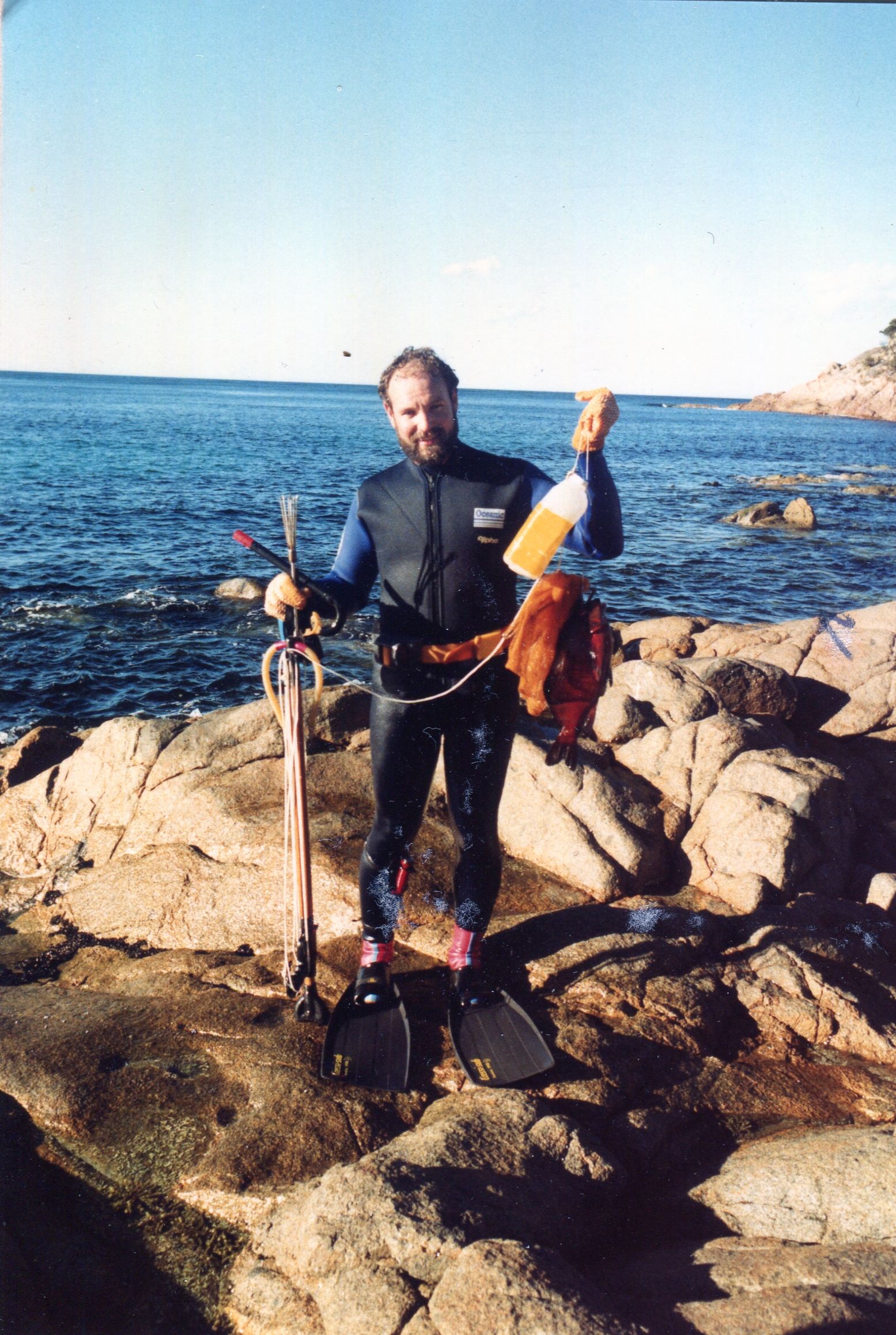
By the time we returned to Coles Bay town it was well after 7:00 PM. Here we filled up with petrol and made our usual Sunday phone calls before having an excellent fish dinner with peas and salad.
Links to other posts
In the beginning: Motivation and Planning
NSW: Merry Beach, Bournda State Recreation Area
Victoria Pt 1: Mallacoota - Lakes Entrance, Lakes Entrance - Melbourne
Tasmania: 1st - 18th February, 19th - 27th February
Victoria Pt 2: 28th February - 12th March
South Australia: 13th March - 27th March
Western Australia Pt 1: 28th March - 17th April
Western Australia Pt 2: 18th April - 5th May
Northern Territory: 6th May - 17th May
Queensland Pt1: 18th May - 31st May
Queensland Pt 2 to Sydney: 1st June - 20th June